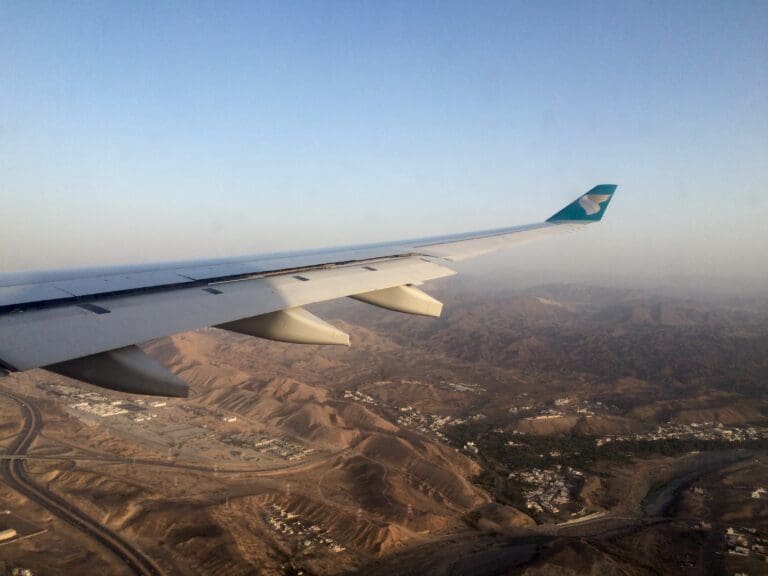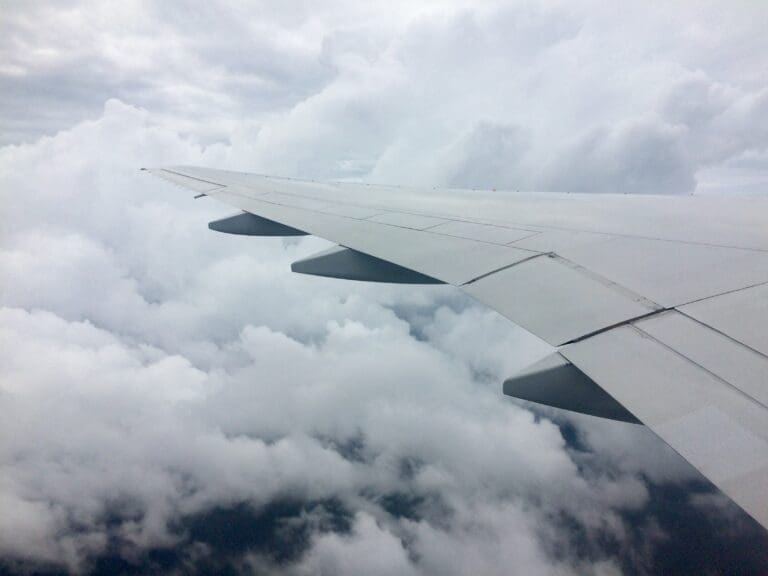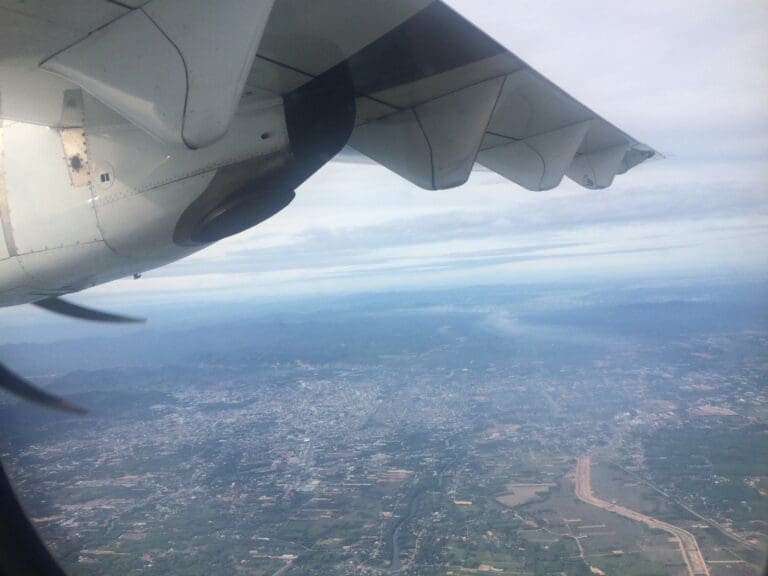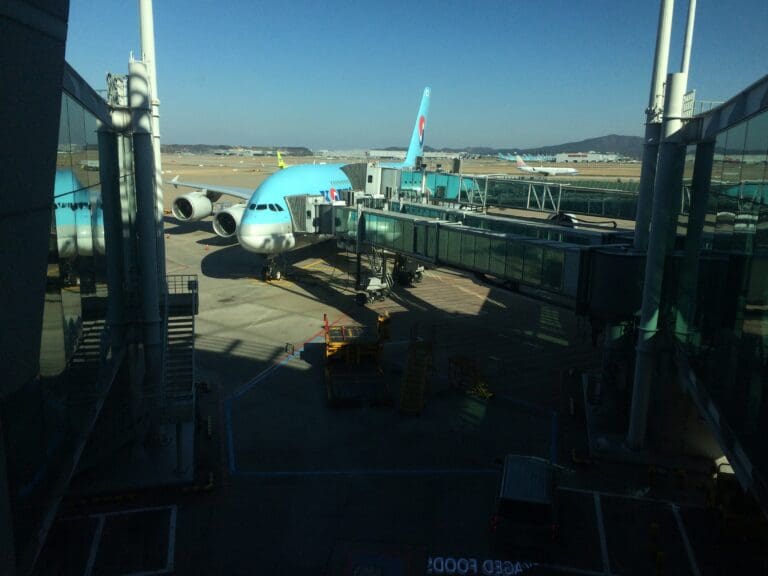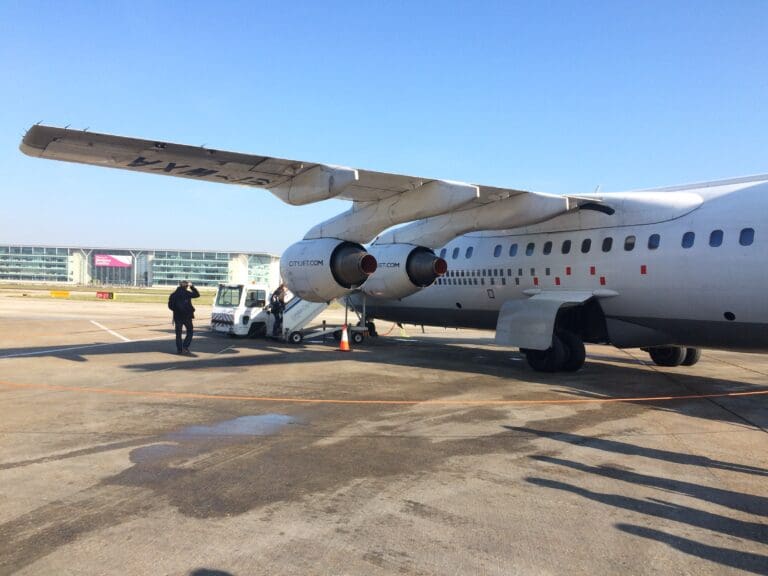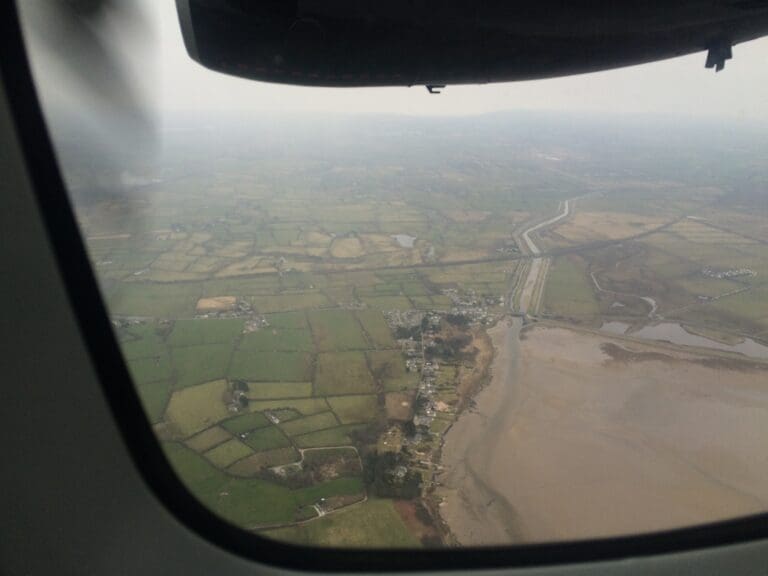A Pleasant Surprise with Plenty of Food: Baku to Kyiv on an Azerbaijan Airlines Airbus A319
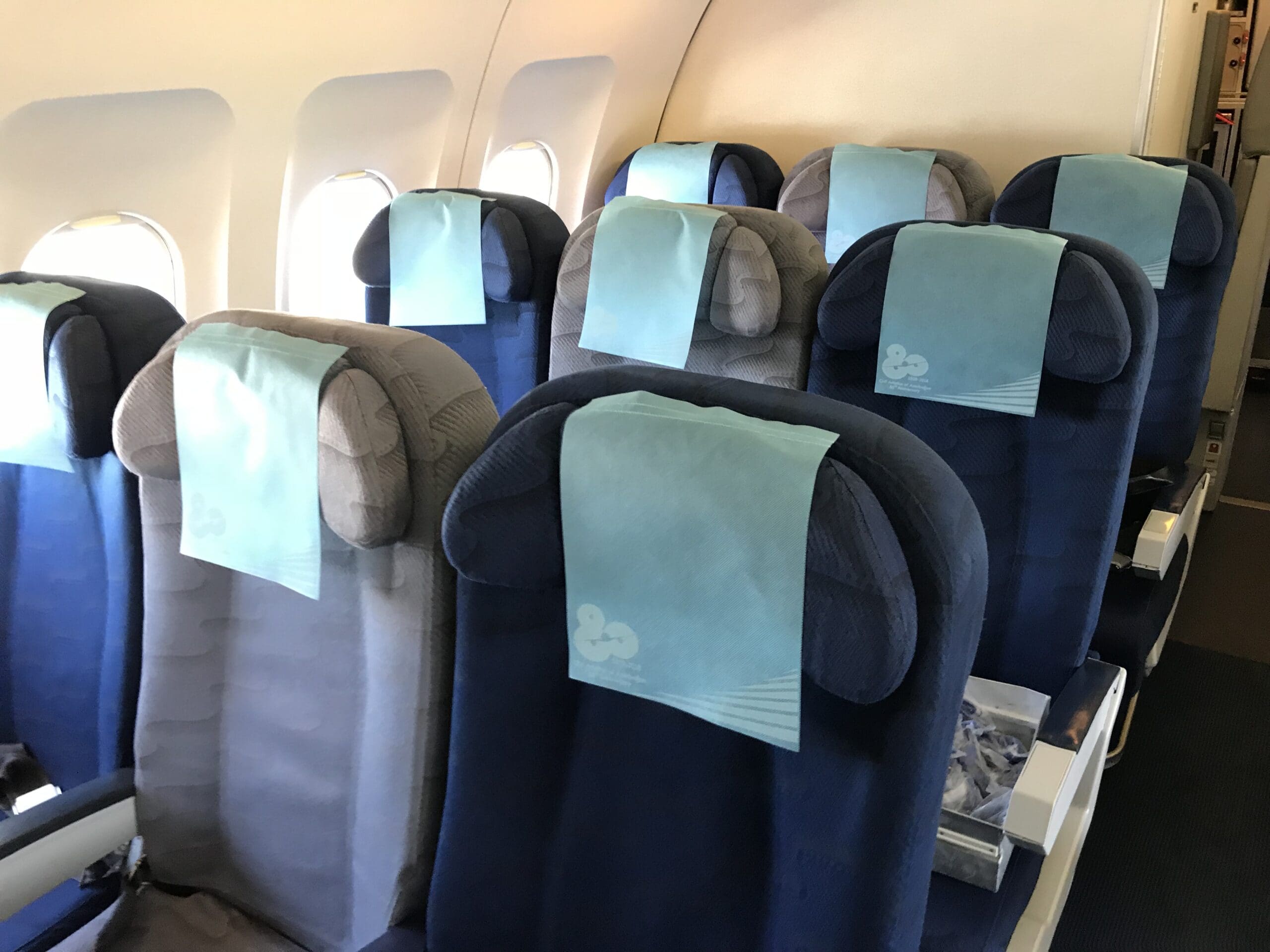
As airports go, Baku Heydar Aliyev International Airport, named after Azerbaijan’s former president, is relatively close to the capital city centre—just twenty kilometres away. However, lacking a rail connection, those wishing to travel to the airport by public transport must do so by road. Fortunately, regular luxury airport bus services shuttle between the city and the airport, with tickets costing a bargain 1.30 Manat (£0.58). Had I been travelling alone, I would likely have chosen this option; however, with a large suitcase, a weary father, and an early morning departure, we opted for the hotel-arranged taxi service, which cost a total of $15. At 06:00, we received the call from reception informing us that the driver had arrived, so we headed downstairs, checked out, and soon sped off through the quiet streets of Baku’s old town.
A short time later, the car arrived at the main road running along the shoreline, Neftchilar Avenue, where an unusually large collection of tanks and rocket-carrying vehicles were being prepared for the city’s Armed Forces Day parade later that day. After heading inland, the car passed the modern and uniquely designed Heydar Aliyev Centre, followed by the city’s Olympic Stadium. As we continued, the buildings surrounding the main road began to taper off, and we entered mostly residential suburban areas. Once the city was behind us, the surroundings became sandier before the car exited the main road, and the airport suddenly appeared.
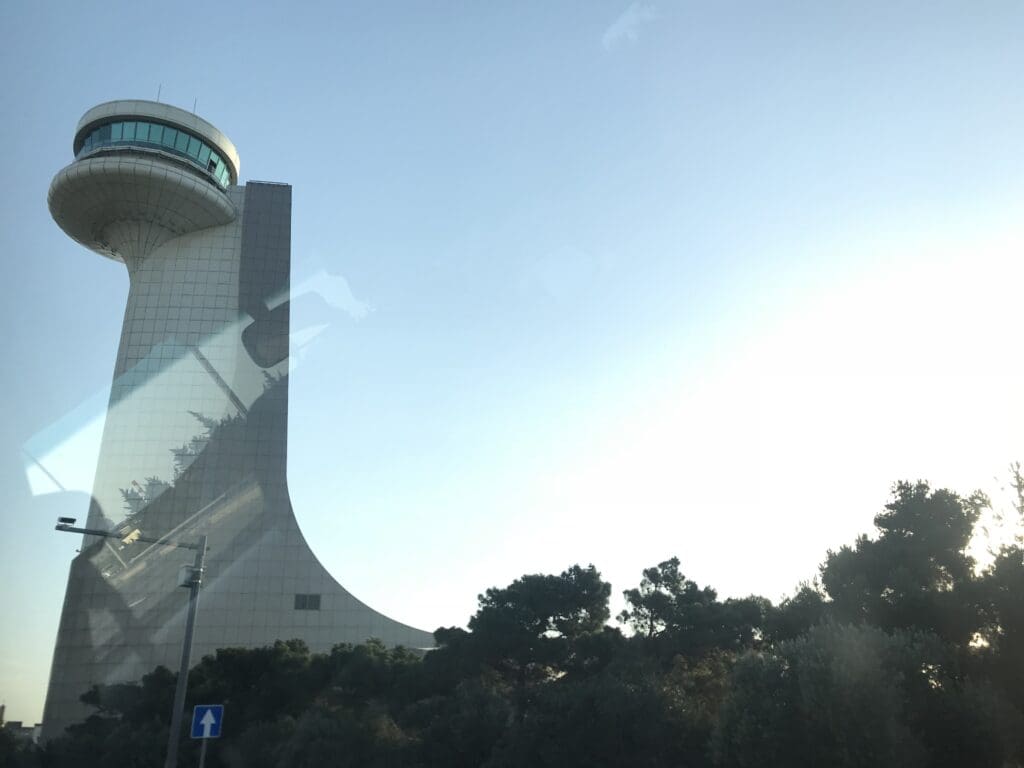
Just over twenty minutes after leaving the hotel, the taxi pulled into the airport car park, located a short distance from the main entrance of the large, modern international terminal, Terminal 1. Meanwhile, at the uniquely designed Terminal 2, one of Azerbaijan Airlines’ Boeing 757s could be seen alongside a pair of Buta Airways Embraers. While these jets were clearly visible, I hesitated to take any photos, having read many reports of enthusiasts getting into trouble for photographing aircraft at the airport. Travelling in early summer, the temperature was already rather hot, so after thanking the driver, we headed straight into the air-conditioned terminal.
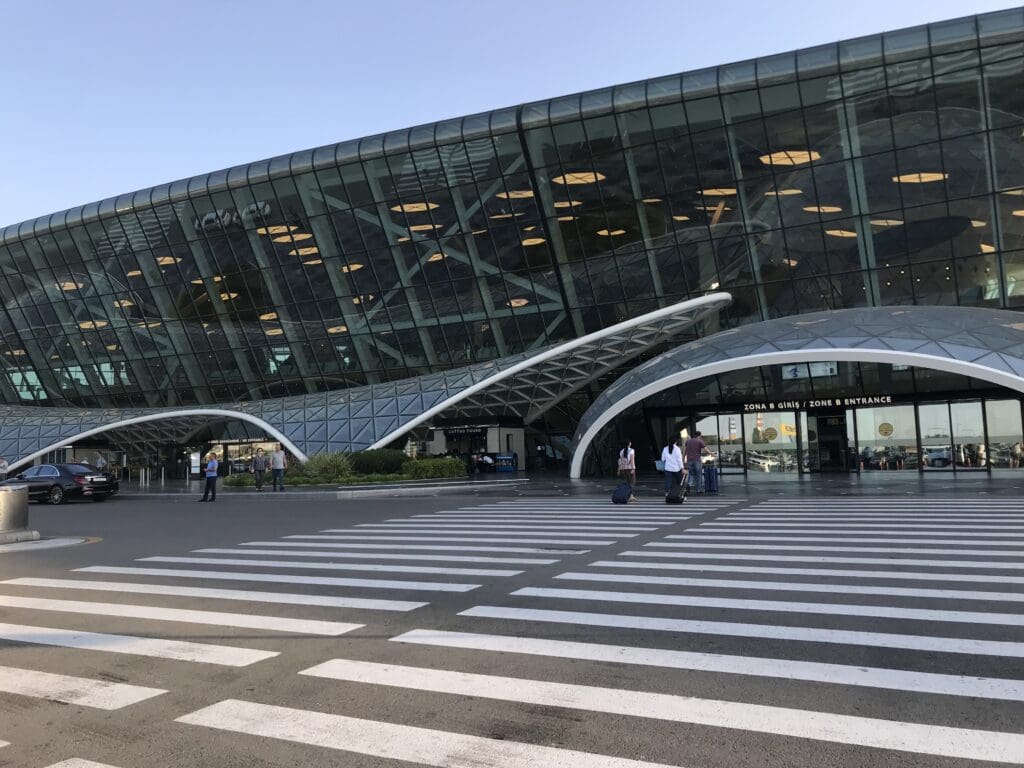
Within a minute, we arrived at the Zone B entrance of the check-in hall, which serves passengers departing on flights operated by foreign airlines. Since our flight to Ukraine was operated by Azerbaijan Airlines, we passed through the quick security check and entered the terminal, walking along it until we reached the large bank of check-in desks dedicated to Azerbaijan Airlines services.
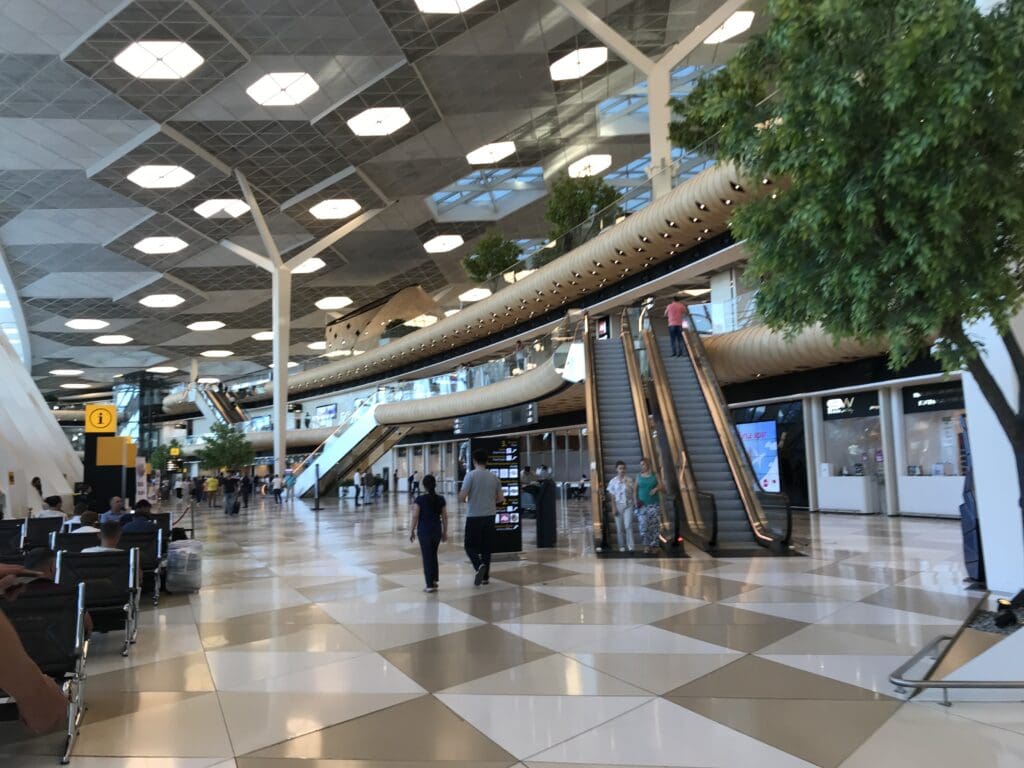
Inside, the airport’s check-in hall seemed modern, large, and spacious. That morning, with Azerbaijan Airlines flights departing for Dubai, Kyiv, Minsk, Moscow, and Tel Aviv, one might have expected the area to be crowded. Thankfully, nearly all check-in desks were open, so the queues were minimal. We walked straight up to a vacant desk where we handed over our passports and booking confirmation. After some swift typing, I requested a window seat. A couple of minutes later, two Azerbaijan Airlines-branded boarding passes emerged, with seat numbers 21B and 21C. Assuming no window seats were available, I double-checked with the staff member, who, appearing to have forgotten my request, apologised before printing new boarding passes with seat numbers 22K and 22L.
Once we had our new boarding passes, we made our way up the escalators to the second security check of the day, passing a McDonald’s on the way and resisting the temptation to stop for breakfast. Unlike Tbilisi Airport the previous day, security here was relatively quick, although the same could not be said for immigration, where we faced a fifteen-minute wait before entering the terminal’s airside area. Fortunately, the wait provided an excellent view of one of Azerbaijan Airlines’ Airbus A340-500s being prepared for its flight to Dubai, as well as the Embraer 170 we had flown in on the previous day. However, considering the photography ban, I thought it best not to take any photos, especially as I was in clear view of the airport’s security officers guarding the no man’s land between security and immigration.
After a quick passport check, we entered the spacious airside departure area. Once Turkish Airlines’ Airbus A321 had departed for Istanbul, Azerbaijan Airlines enjoyed a complete monopoly on departures from the terminal that morning. Outside, every type of aircraft in the airline’s fleet was being prepared for flights to both near and far destinations. Away from the terminal, a host of interesting aircraft types could be seen, including a pair of Ilyushin Il-76TD-90VD jets operated by Silkway Airlines and an older Belarusian Ruby Star Cargo Antonov An-12 from 1969. Like many airports across the former Soviet Union, Baku Airport houses a significant number of stored Soviet-built aircraft types, sadly unlikely to ever fly again.
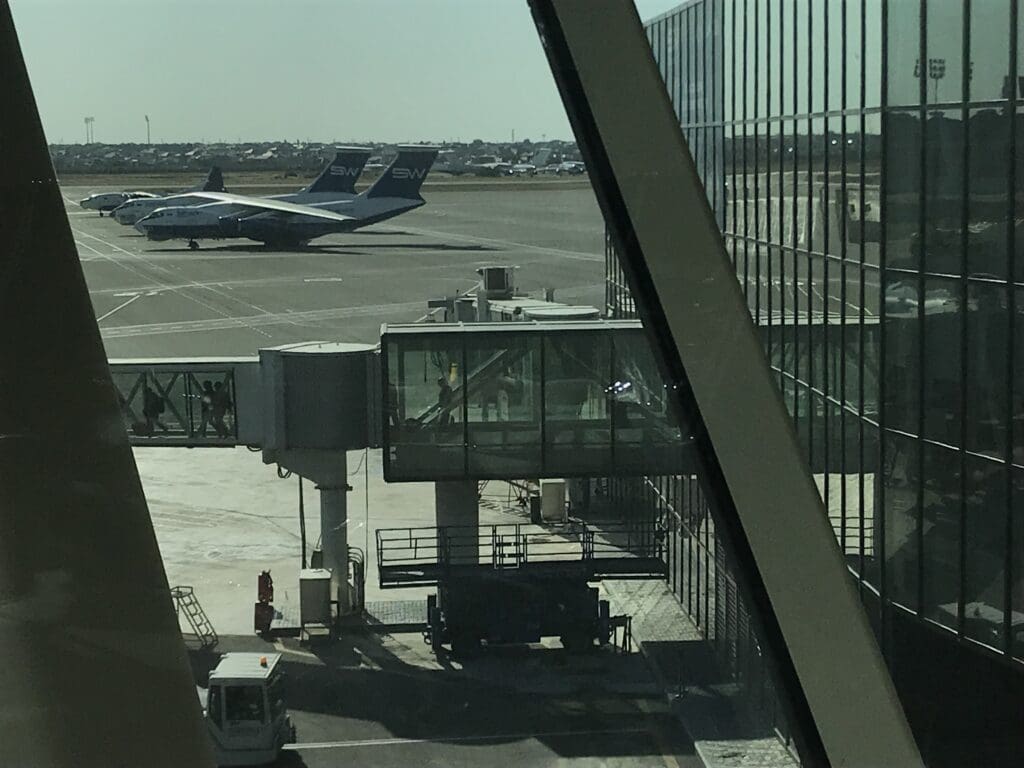
Inside the terminal, signs boasting of the airport’s five-star Skytrax rating were omnipresent, placing Baku in the same league as international hubs like Doha Hamad, Munich, Singapore Changi, and Tokyo Haneda. Architecturally, the airport’s design is modern, spacious, and visually pleasing, while its simple layout makes it easy to navigate. Furthermore, ample seating was available that morning, along with fast, complimentary Wi-Fi and plenty of plug sockets and USB ports. Aside from the usual selection of eateries and shops, one of the terminal’s more unusual features is its expensive spa, where passengers can enjoy various treatments before their flights. The only downside, aside from the immigration queues, was the poor state of the toilets, which I found surprising given the near-spotless condition of the rest of the terminal.
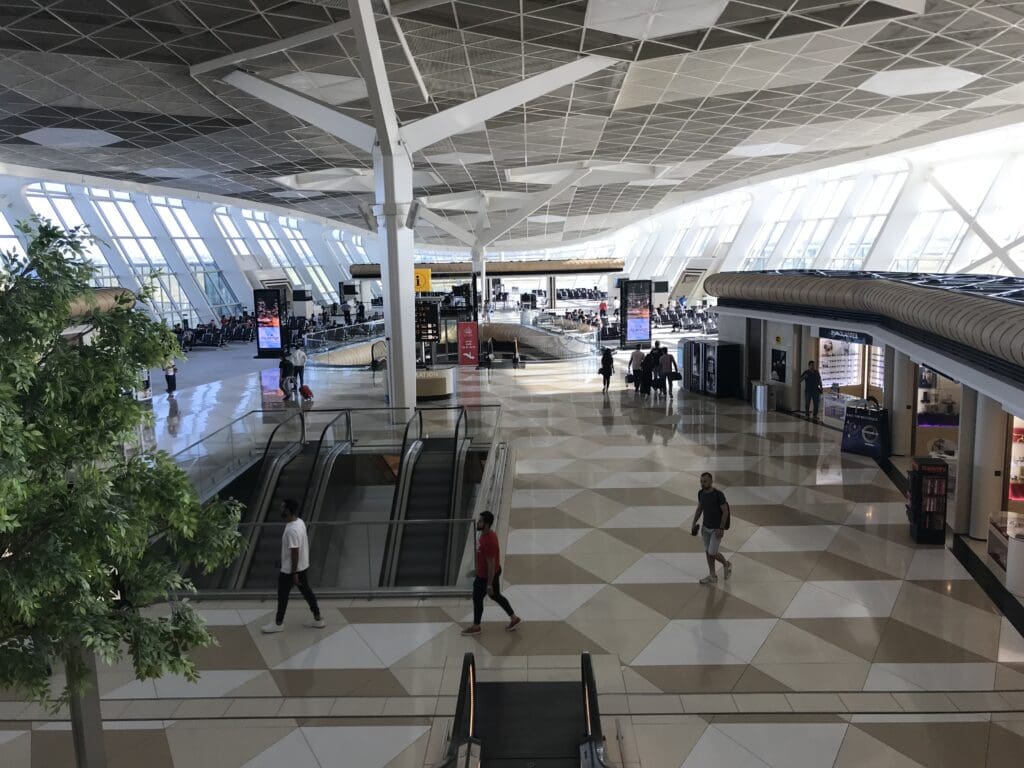
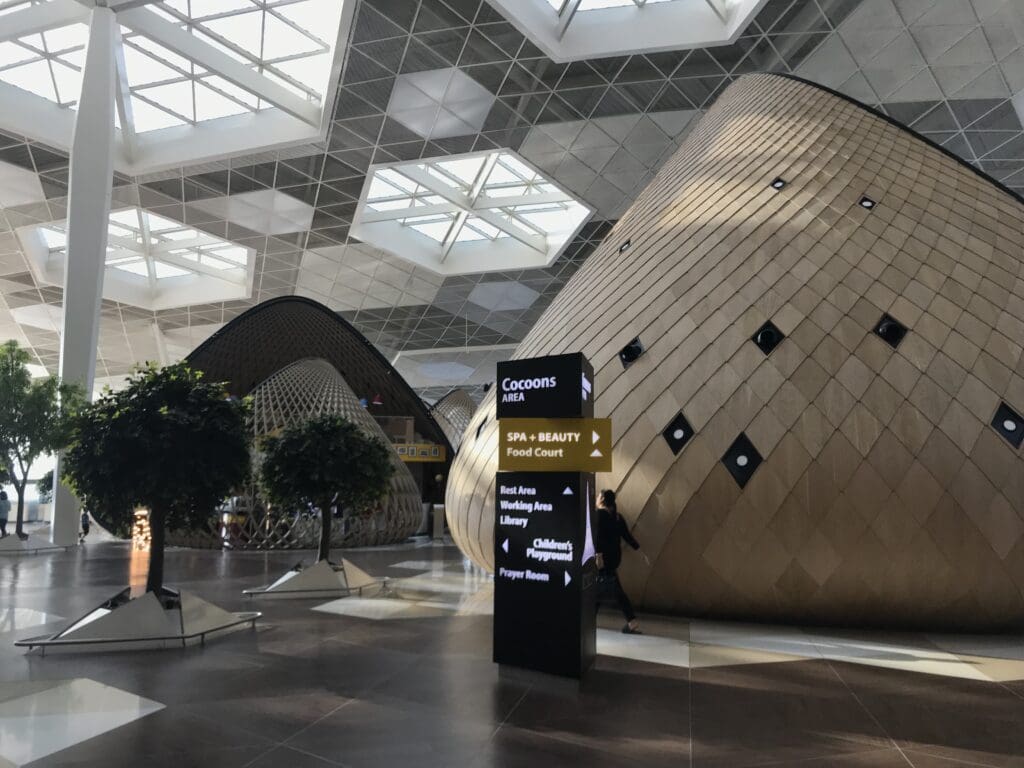
While waiting, I decided to visit one of the airport’s wooden cocoons housing a café, where I bought two slices of cake and two cappuccinos for 20 Manat. At around £8.90, this was a little more expensive than one might expect in Baku, but for an airport café, it wasn’t extortionate. As I enjoyed my cappuccino, I browsed a copy of the June 2018 edition of Azerbaijan Airlines’ inflight magazine, which had been placed around the terminal. Before long, the scheduled boarding time for the Kyiv flight, 08:05, was approaching, so we headed to Gate 8 five minutes prior. Upon arrival, the area around the gate appeared incredibly busy, although most of those waiting were heading to Istanbul on one of the airline’s Boeing 787-8 Dreamliners at the neighbouring gate.
Boarding began on schedule at 08:05, and about a minute later, my boarding pass was scanned and passport briefly checked before I headed down the jetway towards the waiting aircraft. That morning, the flight to Kyiv was operated by 4K-AZ04, an Airbus A319-111 named Guba, a city in northern Azerbaijan. Assembled at Airbus’ Hamburg Finkenwerder plant, the aircraft first flew in mid-October 2005, with test registration D-AVXJ, before being delivered to the airline at the end of the month. While the first few years of its life were uneventful, in August 2010, it overran the runway in Istanbul, resulting in the collapse of its nose gear. Despite the severity of the incident, the aircraft was repaired and returned to service by mid-2011. After Azerbaijan Airlines’ rebrand in 2013, the aircraft was repainted in the airline’s new livery.
Traditionally, Azerbaijan Airlines has deployed its Airbus A319 fleet on longer routes, including Aberdeen, Berlin, Heathrow, Milan, and Paris CDG. While the Aberdeen route has since been discontinued and Heathrow services upgraded to the Boeing 787, the A319 fleet still operates long routes, with flight times up to five and a half hours. In the week before my flight, 4K-AZ04 operated 24 flights, connecting Baku with cities such as Ankara, Bahrain, Lviv, Minsk, and St Petersburg, covering over 26,000 miles.
Upon entering the forward galley of the Airbus, I received a warm welcome from the two crew members in both English and Russian. After turning right, I passed through the business class cabin, which consisted of two rows of large, well-padded seats in a 2-2 configuration, before entering the 114-seat economy cabin. The economy seats were covered in either dark blue or grey fabric and featured adjustable headrests, with each seat adorned with a disposable light blue antimacassar commemorating the 80th anniversary of Azerbaijan’s civil aviation industry. While the seats had a somewhat old-fashioned style, including large armrests with ashtrays, they were as comfortable as they looked, offering plenty of legroom. Despite being Azerbaijan Airlines’ third-oldest jet, I found few signs of wear and tear, and the area around my seat was acceptably clean. The seatback pocket contained the airline’s inflight magazine, a laminated safety card, and a sickbag.
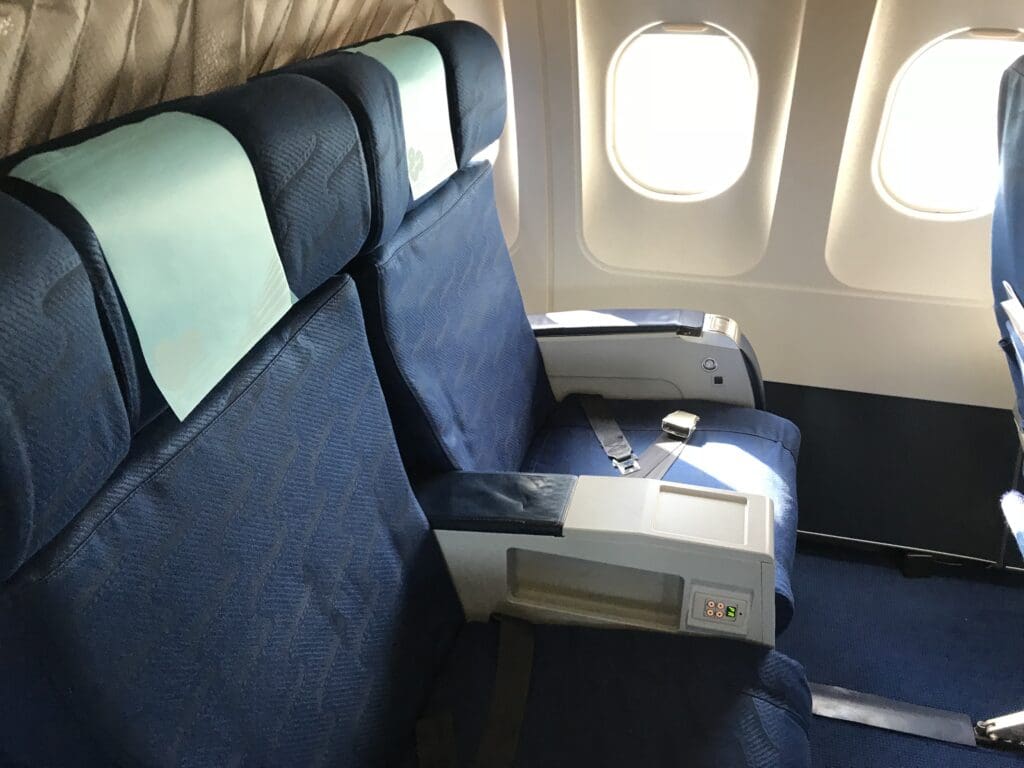
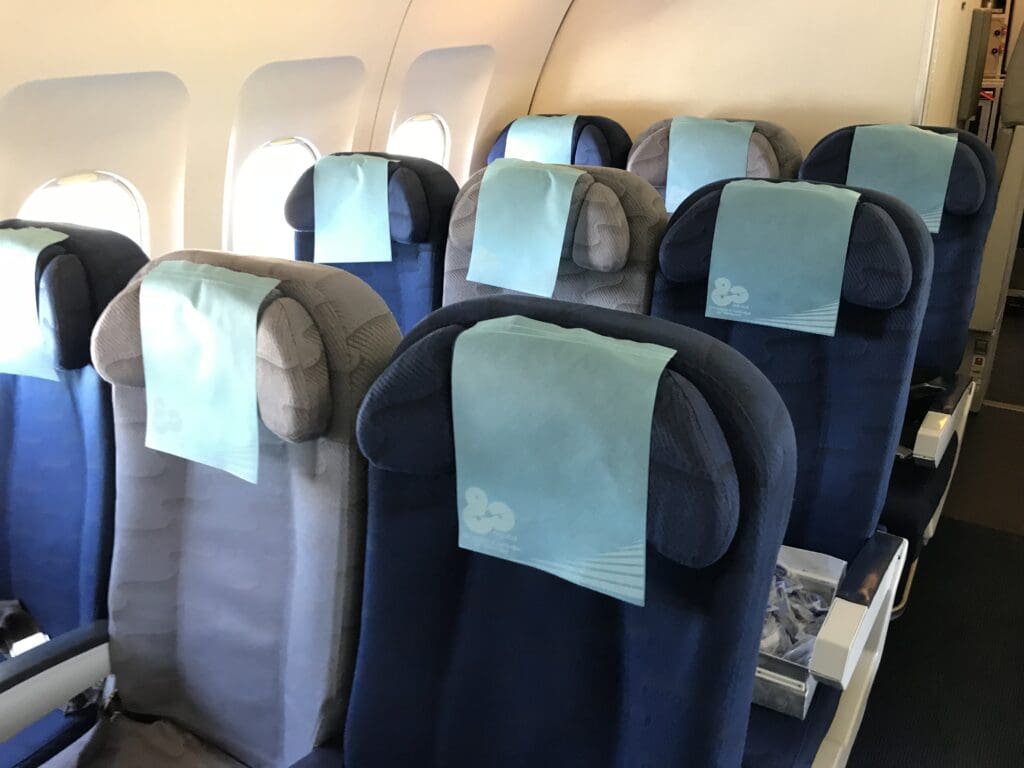
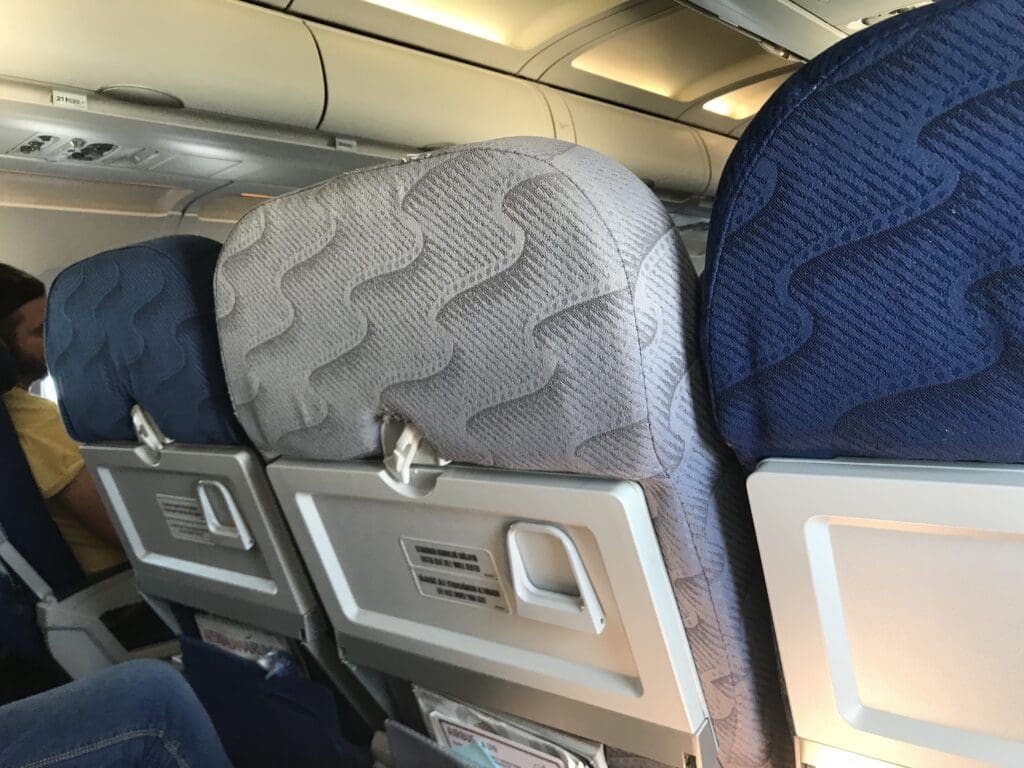
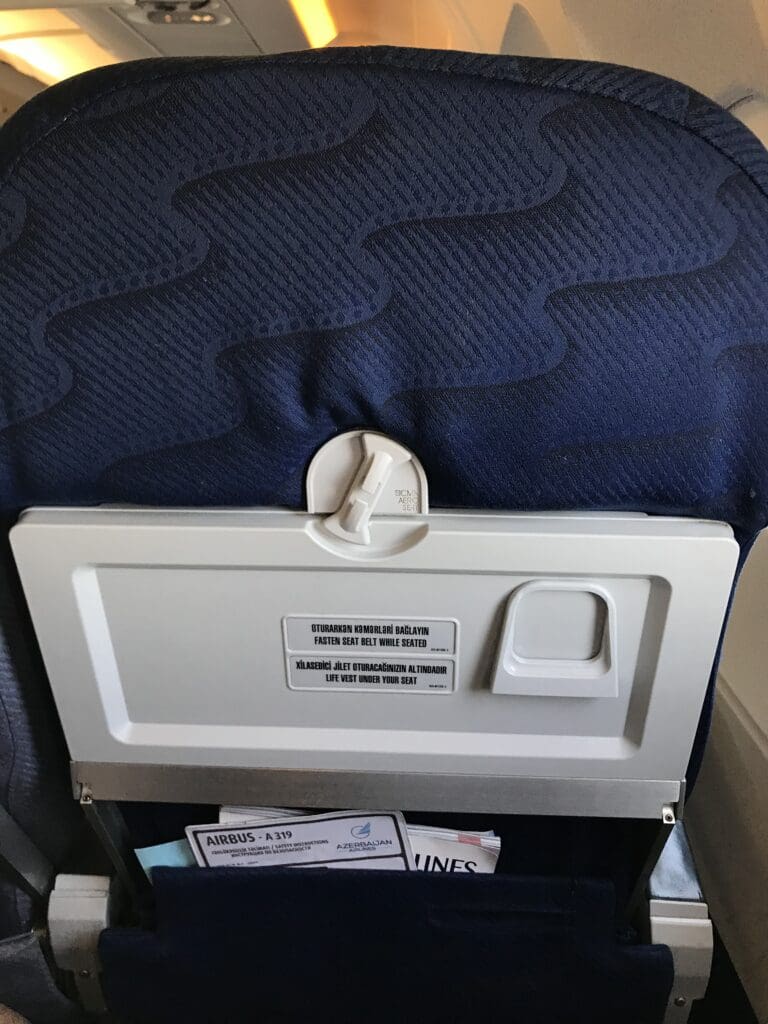
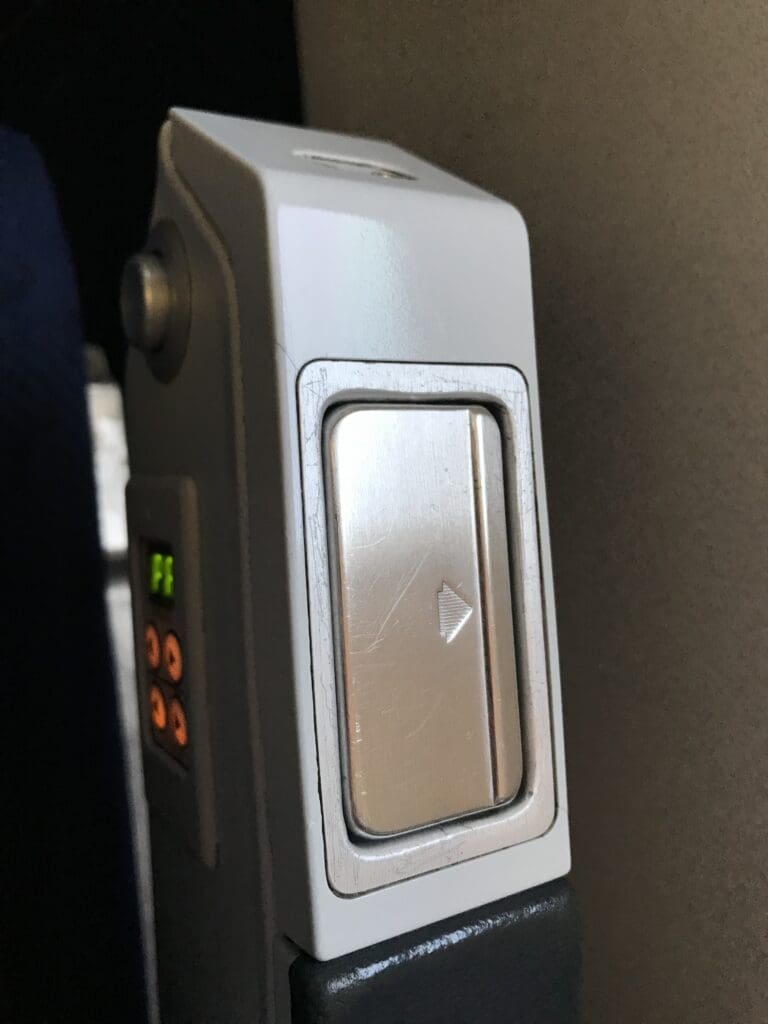
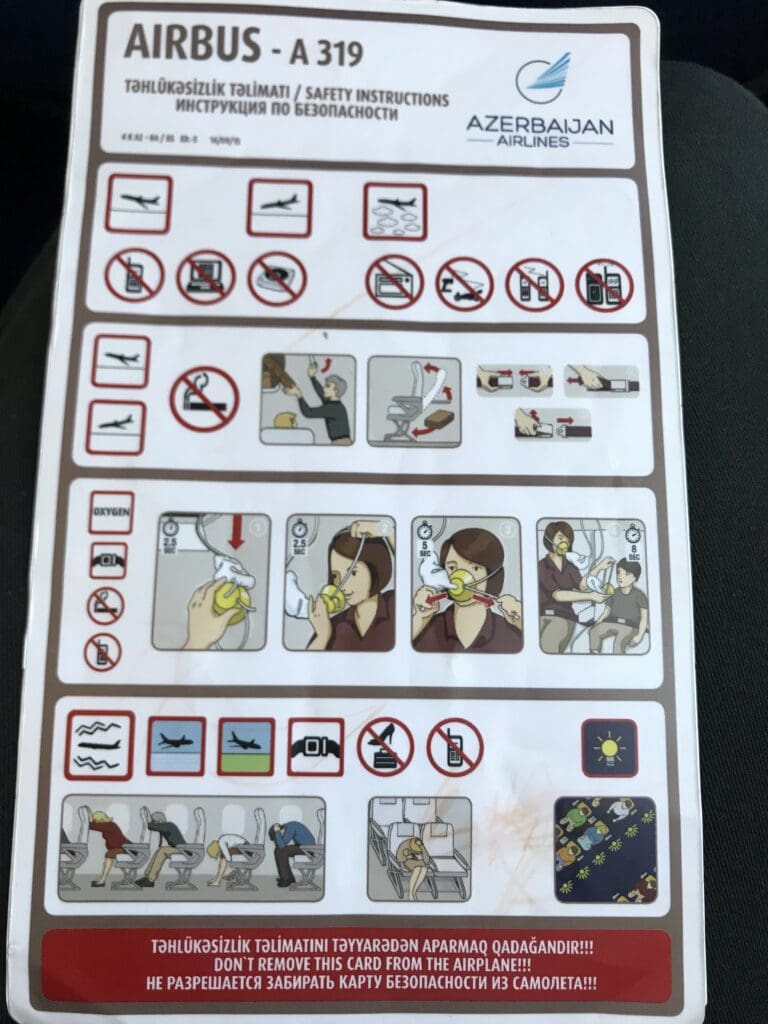
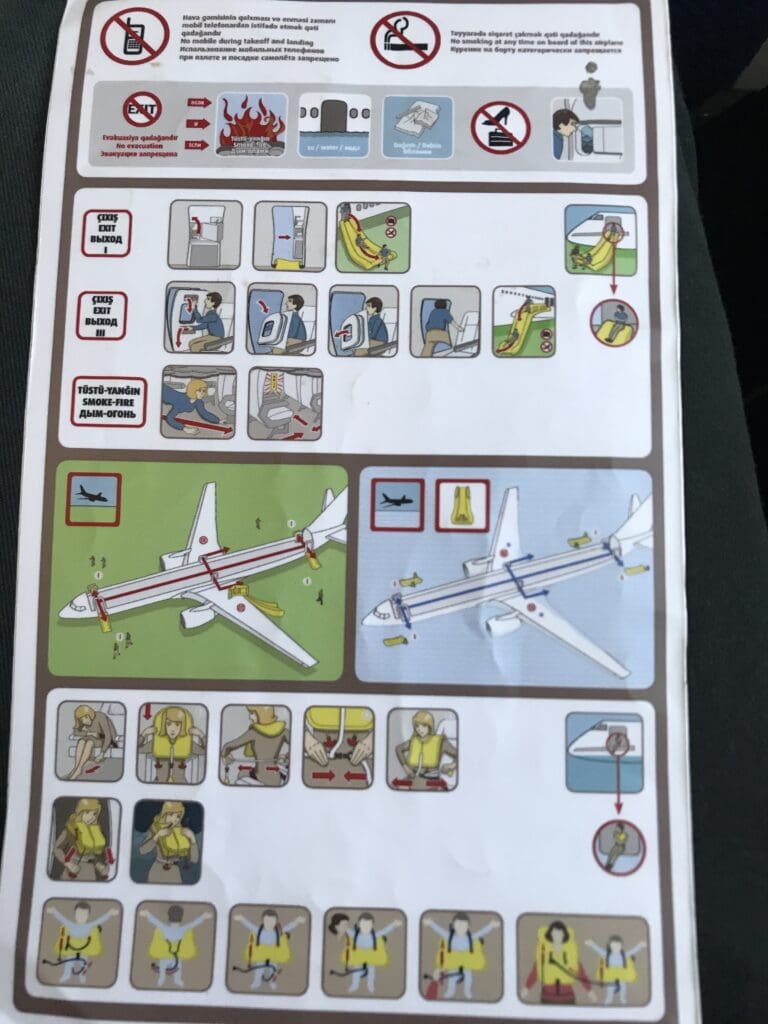
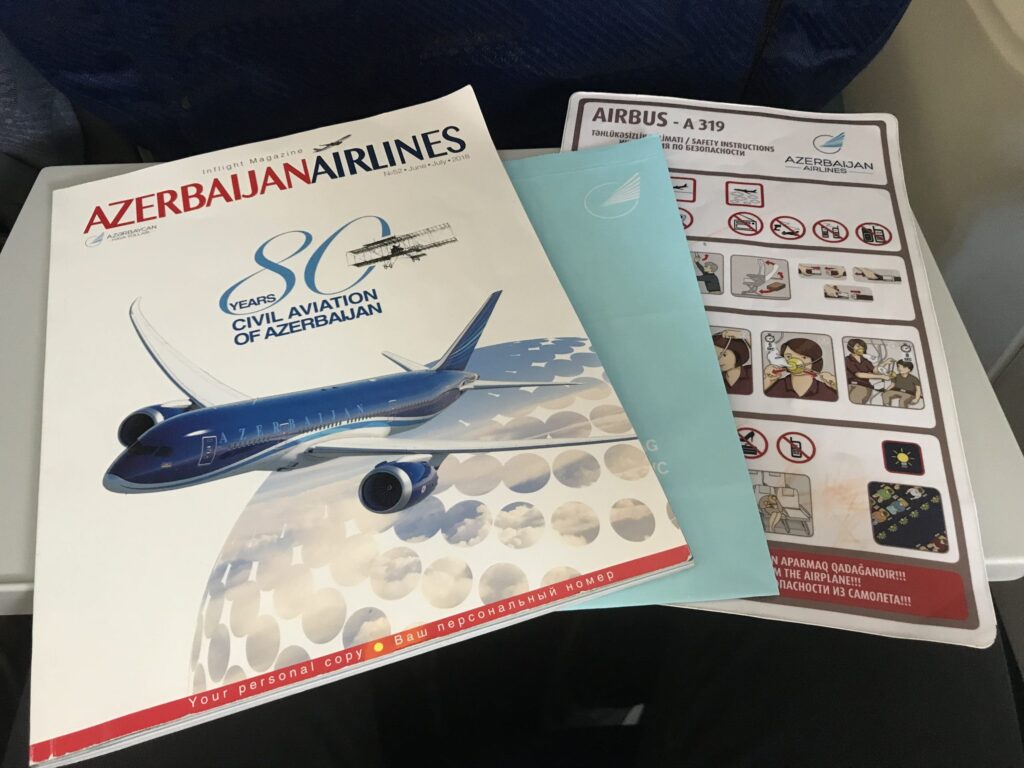
During boarding, a montage of Baku-related promotional videos was played on the aircraft’s overhead screens, accompanied by traditional music. Although passengers boarded slowly, by 08:30, the last passenger had arrived, and the main cabin door remained open until 08:45. At this time, the cones around both our Airbus A319 and the neighbouring Boeing 787-8 were removed simultaneously, and both aircraft pushed back at the same time, albeit in opposite directions. As the Airbus reversed, the purser made their welcome announcement in Azeri, English, and Russian, followed by the airline’s safety video. The typical Airbus A320 Family ‘barking dog’ noise rang through the cabin before the two CFM56 engines powered up, and the aircraft made its way to Runway 17.
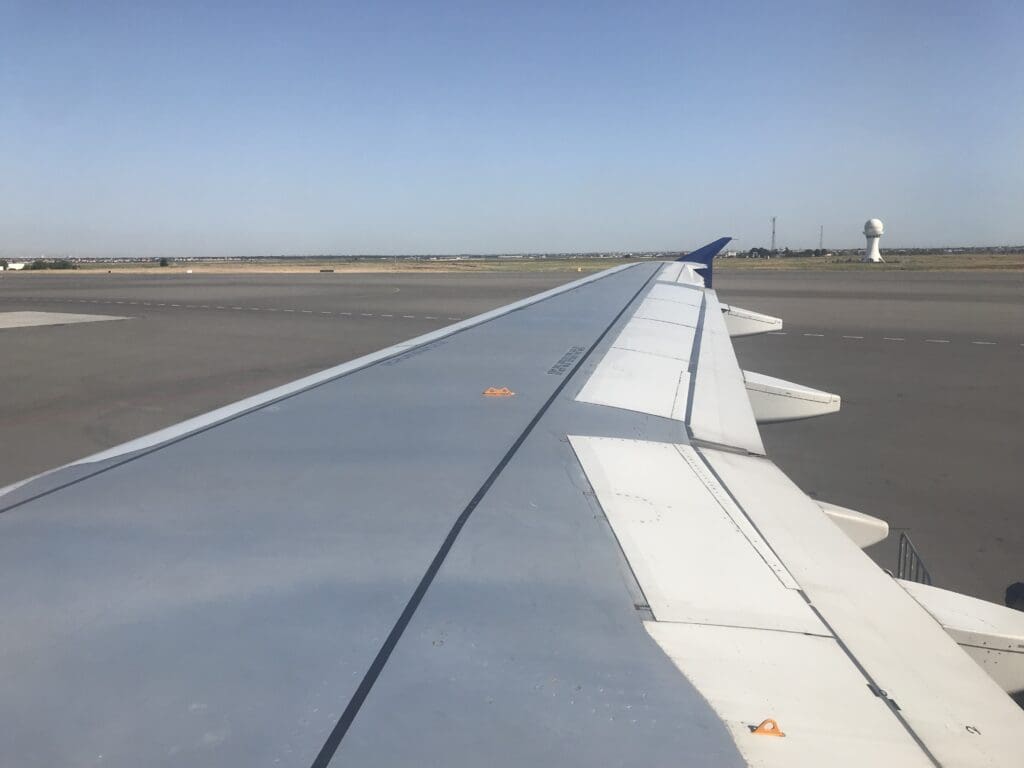
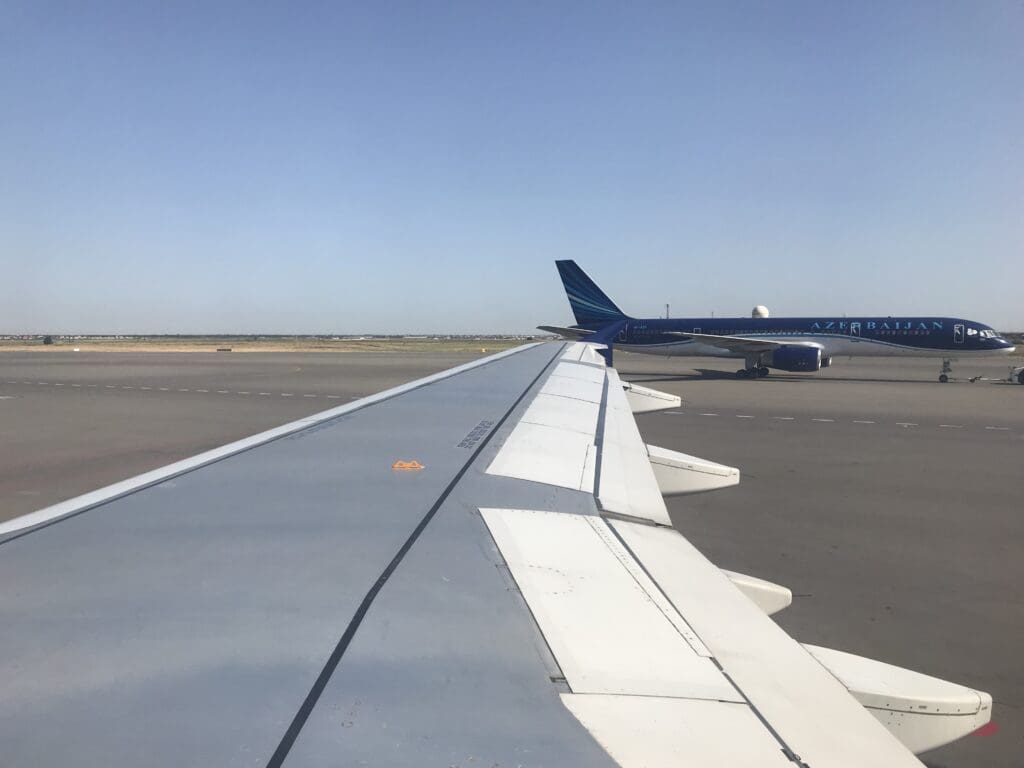
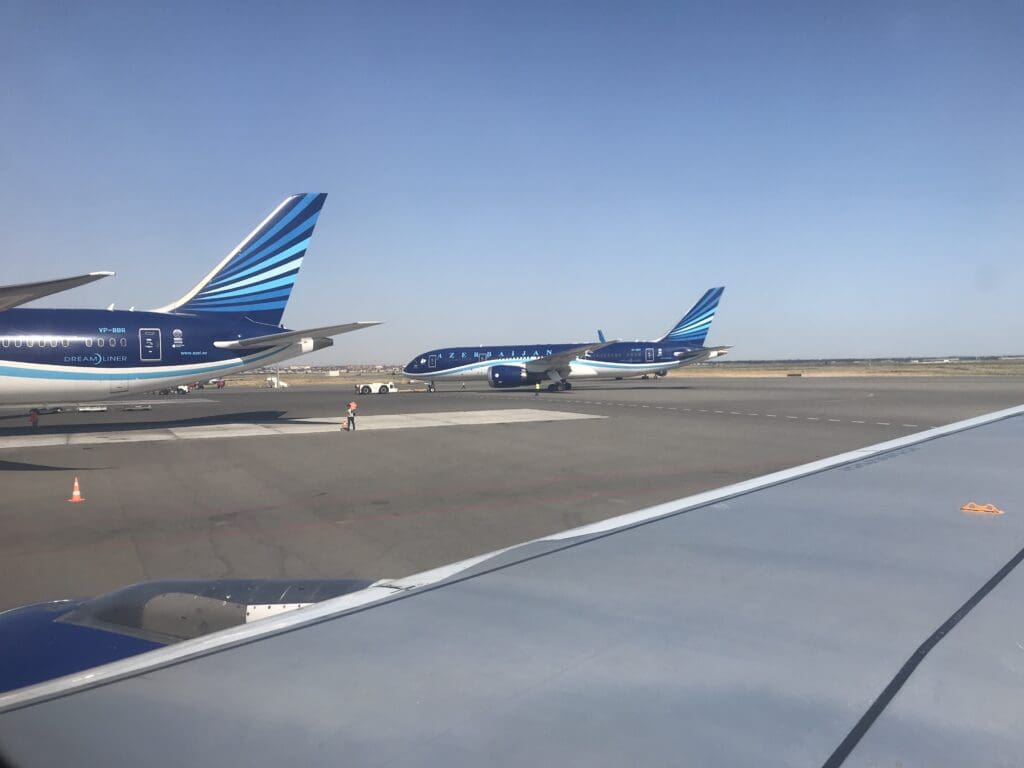
After a short taxi, the aircraft reached the end of the runway at 08:59 and rolled straight onto it without stopping. The takeoff was smooth, offering good views of a line of seven Boeing 747 freighters, including a pair of rare Boeing 747-200Fs operated by Georgian airline Geo-Sky. Once airborne, the aircraft ascended over the sandy landscape around Baku before heading north towards the Russian border.
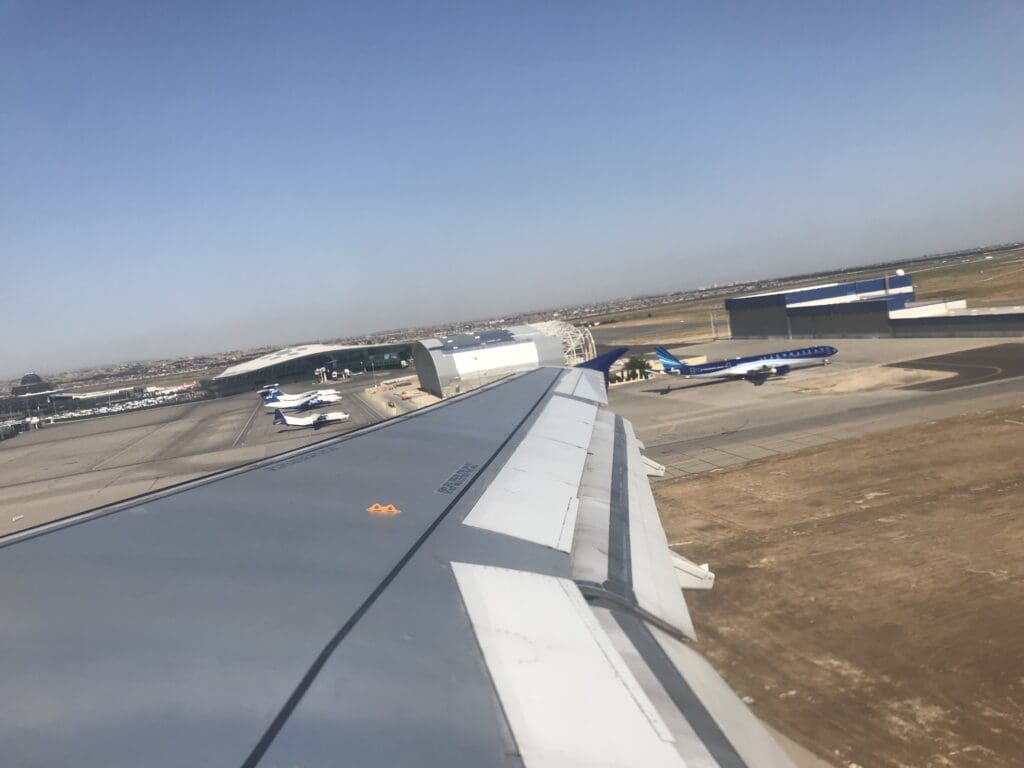
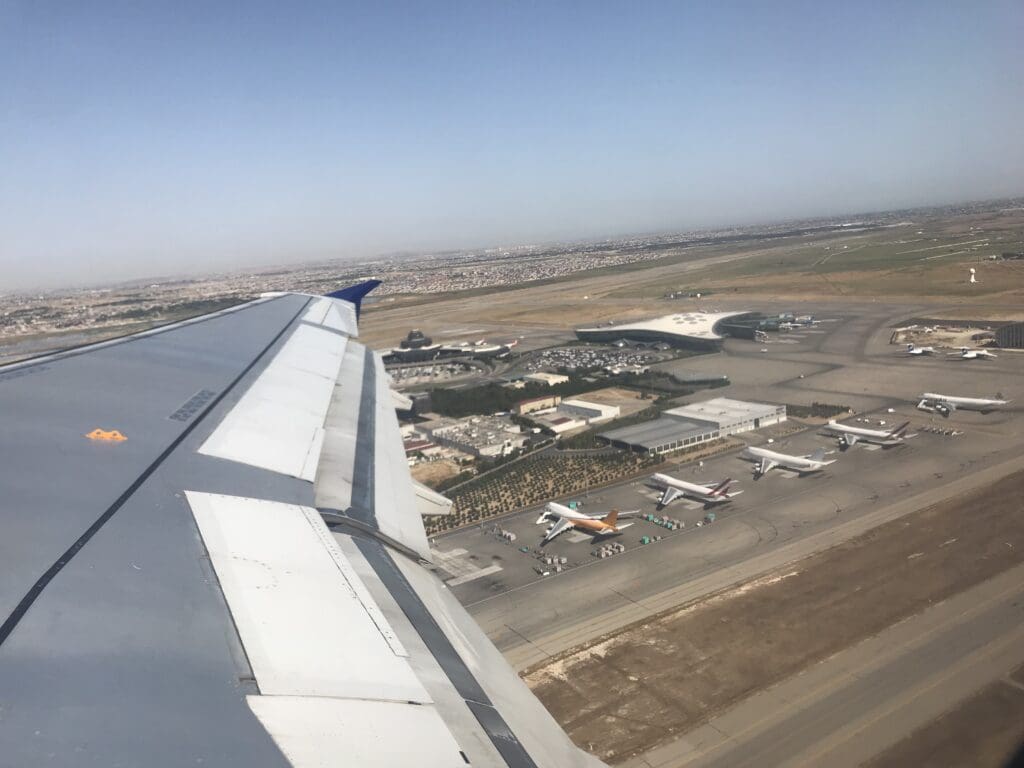
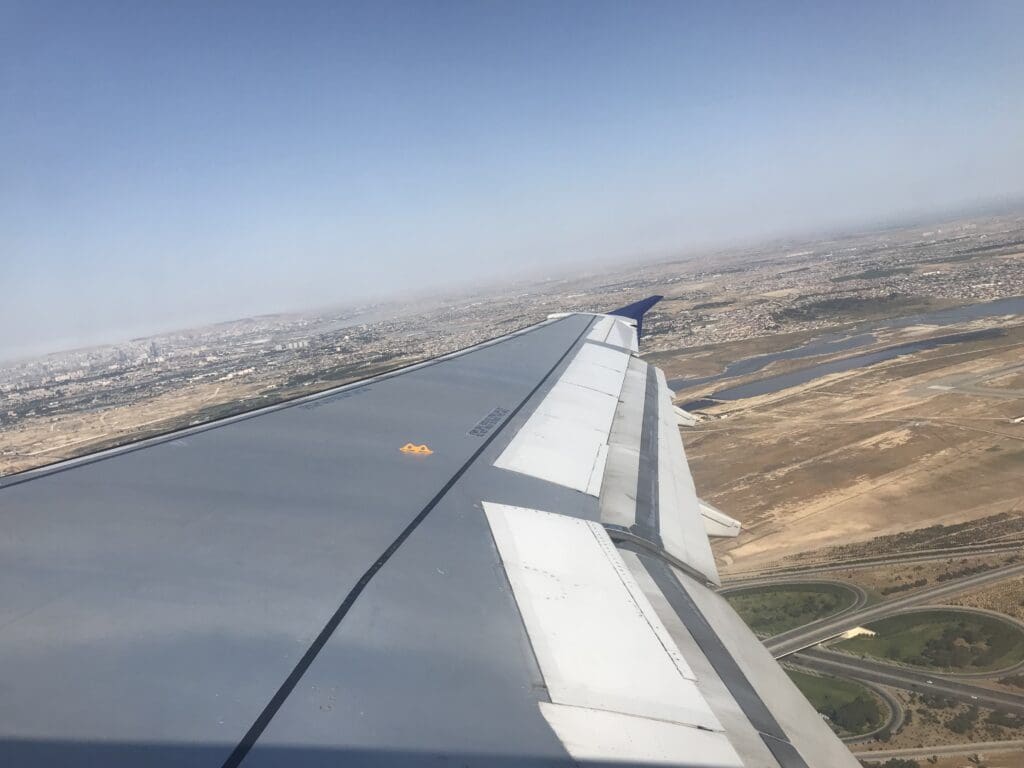
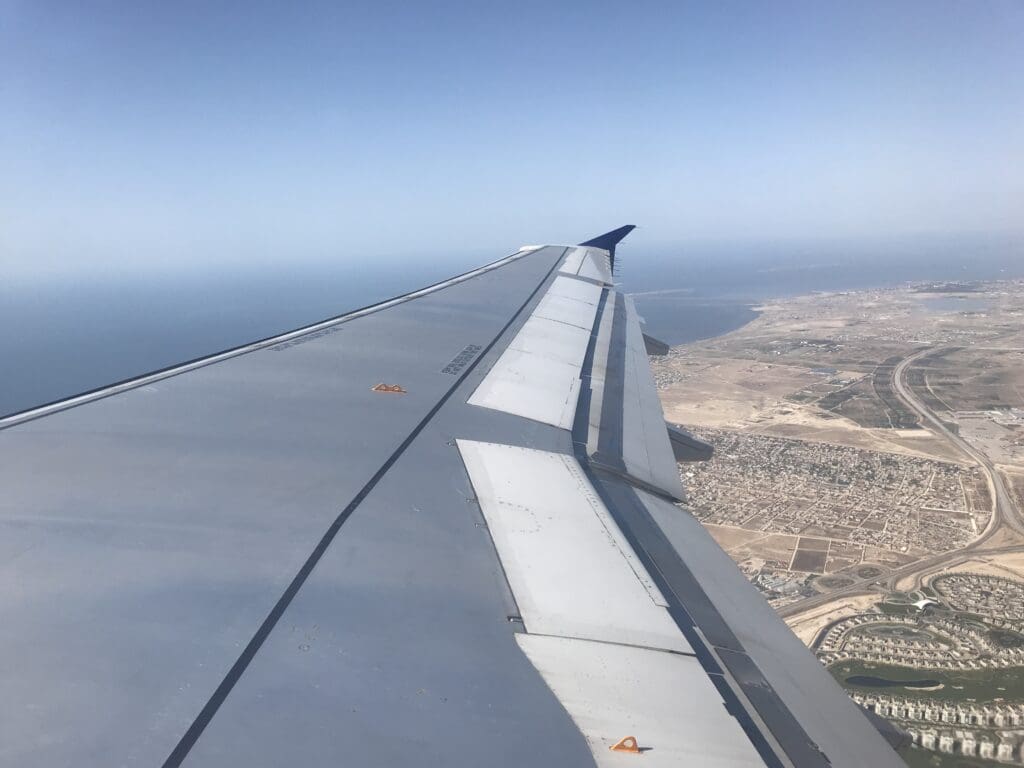
Six minutes after takeoff, the seatbelt signs were switched off, and the purser made the usual announcement regarding keeping seatbelts fastened. The crew then distributed hot towels while the overhead screens began the inflight entertainment, starting with an advertisement for the airline’s frequent flyer programme, AZAL Miles. This was followed by a couple of Azerbaijani government-related videos before the main film, Narnia: The Voyage of the Dawn Treader began. However, most passengers, including myself, paid little attention to the film.
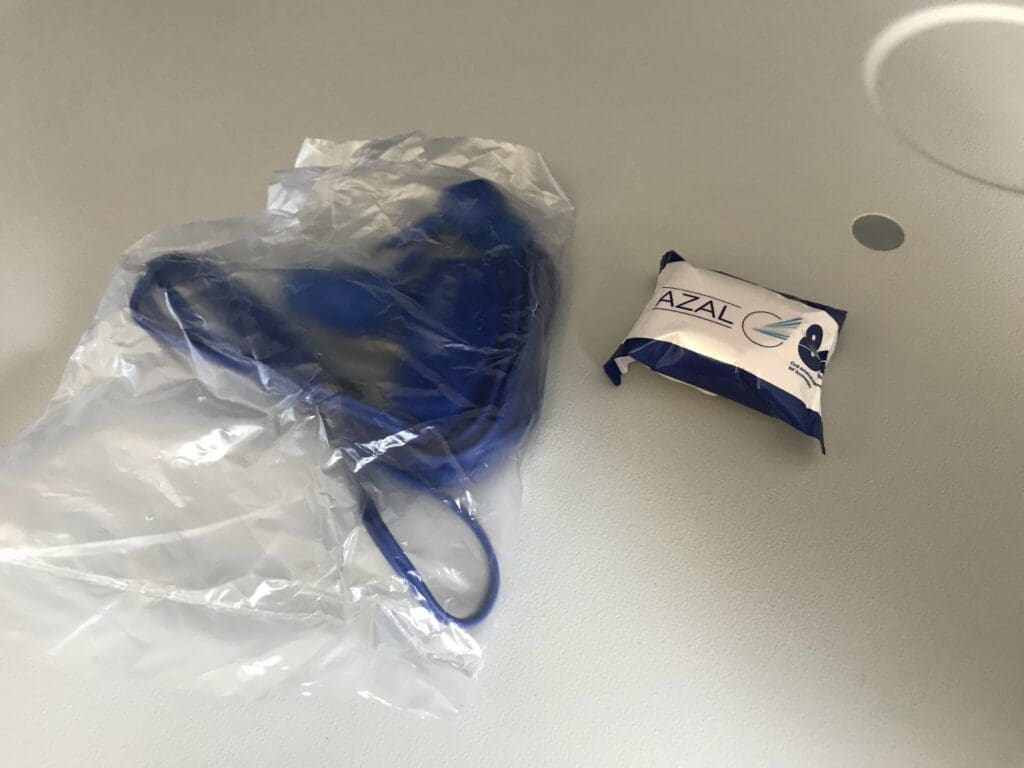
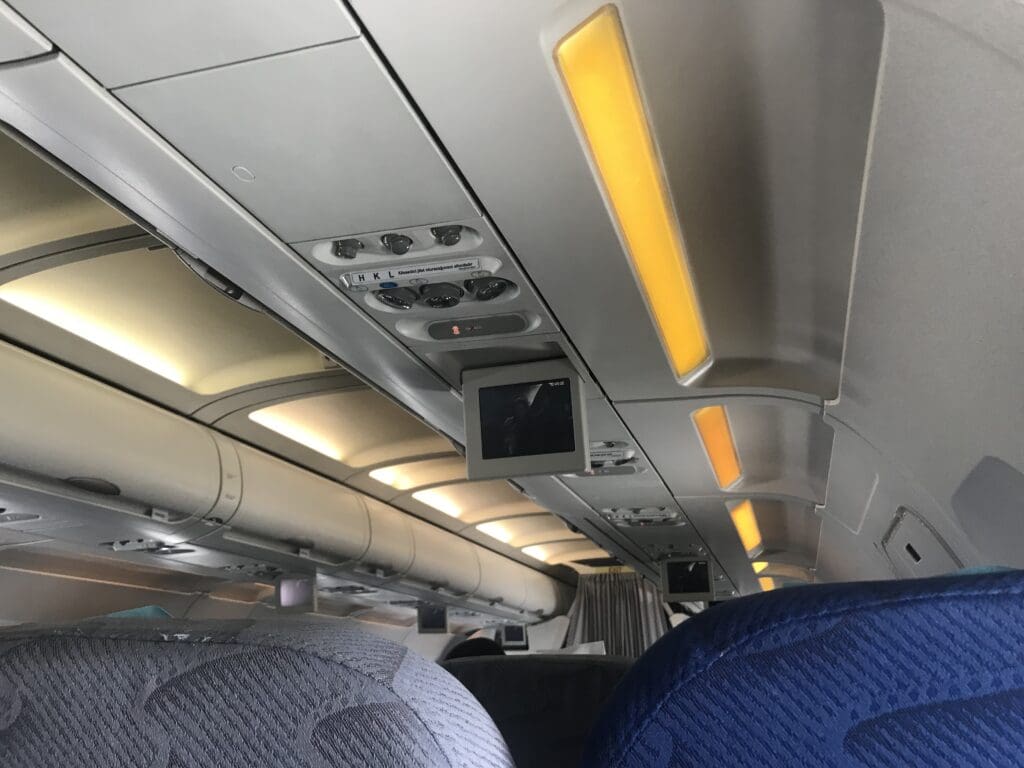
As the aircraft reached cruising altitude, the inflight breakfast service began. Given the light load, it reached our row fairly quickly. One of the crew members cheerfully asked, “Sausage or cake?” My father opted for the sausage, while I chose the cake. The tray included a Danish pastry swirl, a cold slice of meat with an olive and two types of cheese, a croissant with jam and butter, and a warm, sickly-sweet apple cake doused in custard. While the meal was decent and offered a large selection for a three-hour flight, I regretted choosing something so sweet so early in the morning. About twenty minutes later, the crew passed through with tea, coffee, and packaged hazelnuts.
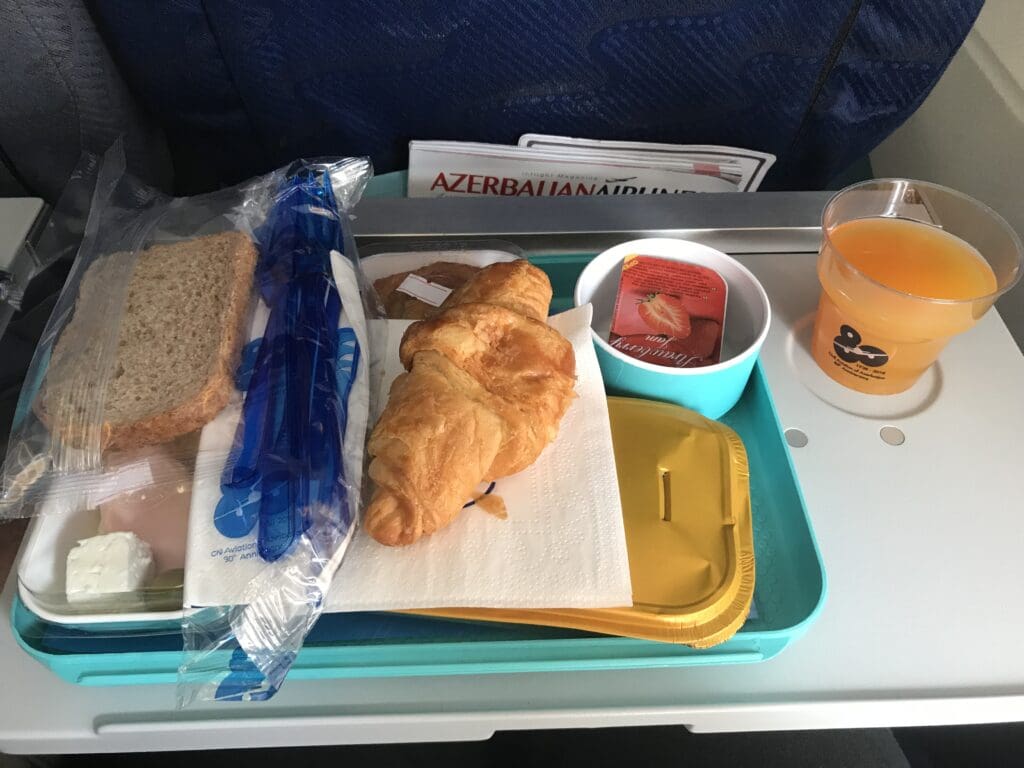
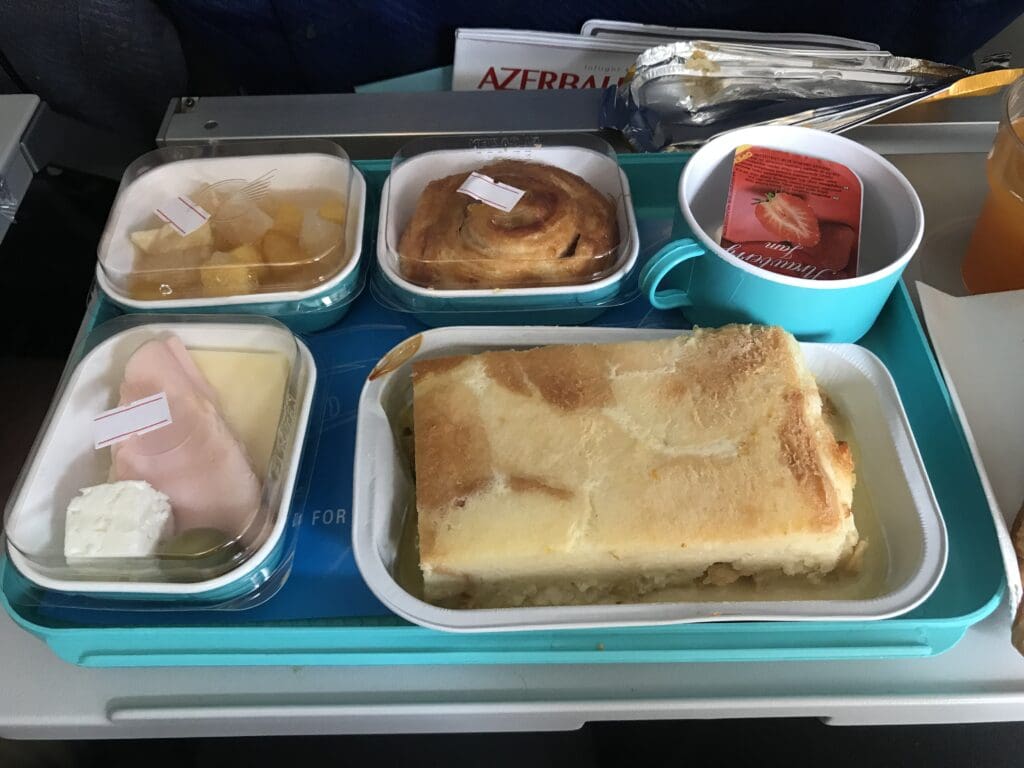
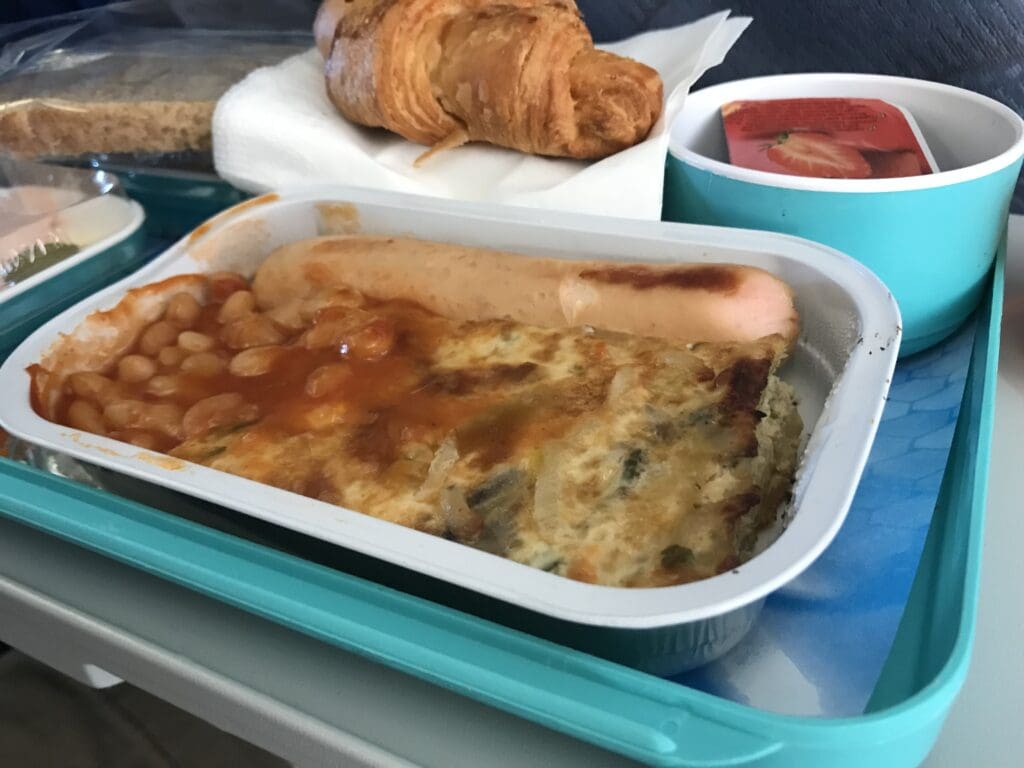
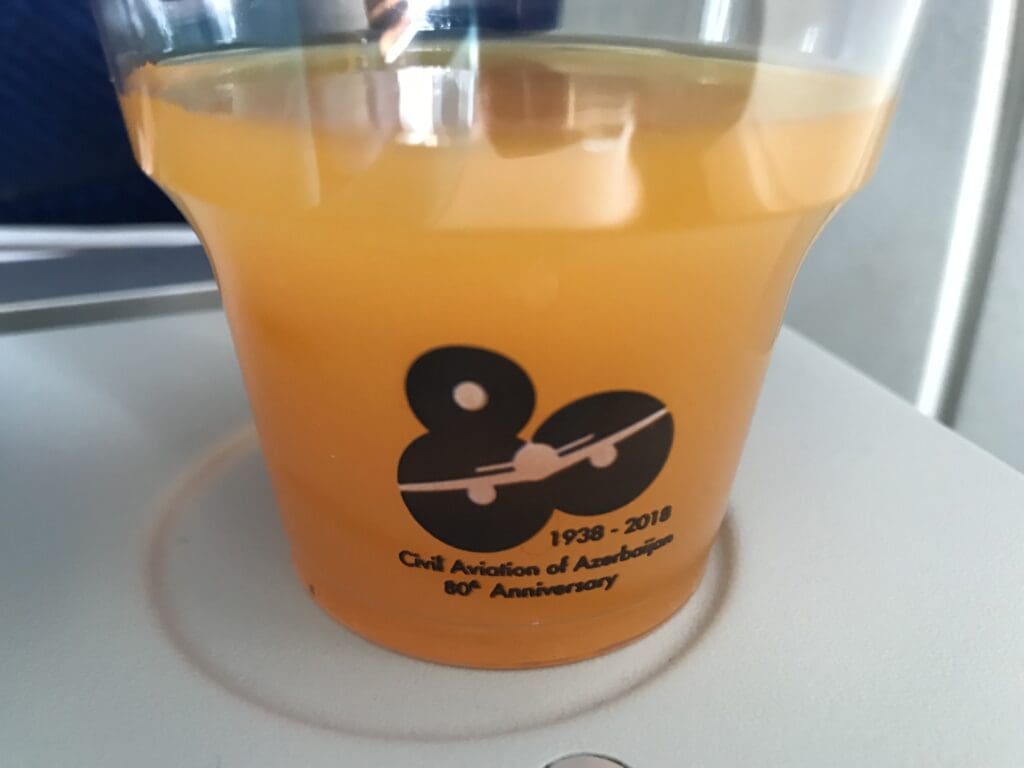
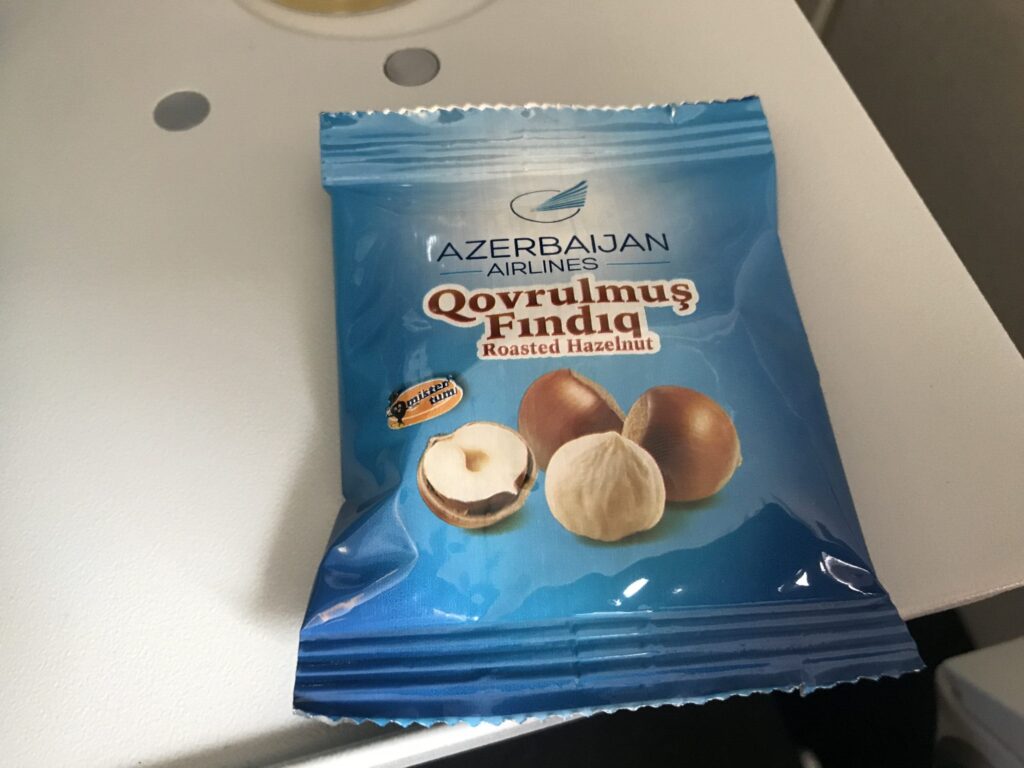
Outside, the skies remained cloudy as the Airbus headed north up the Caucasus, but occasional gaps revealed the increasingly green landscape of Southern Russia. After the crew cleared the rubbish, the flight remained smooth until a brief period of turbulence, which resulted in the reillumination of the seatbelt signs. After a pre-recorded announcement in Russian, the purser reminded passengers to fasten their seatbelts in Azeri and English. About fifteen minutes later, the turbulence subsided, and the seatbelt signs were switched off again.
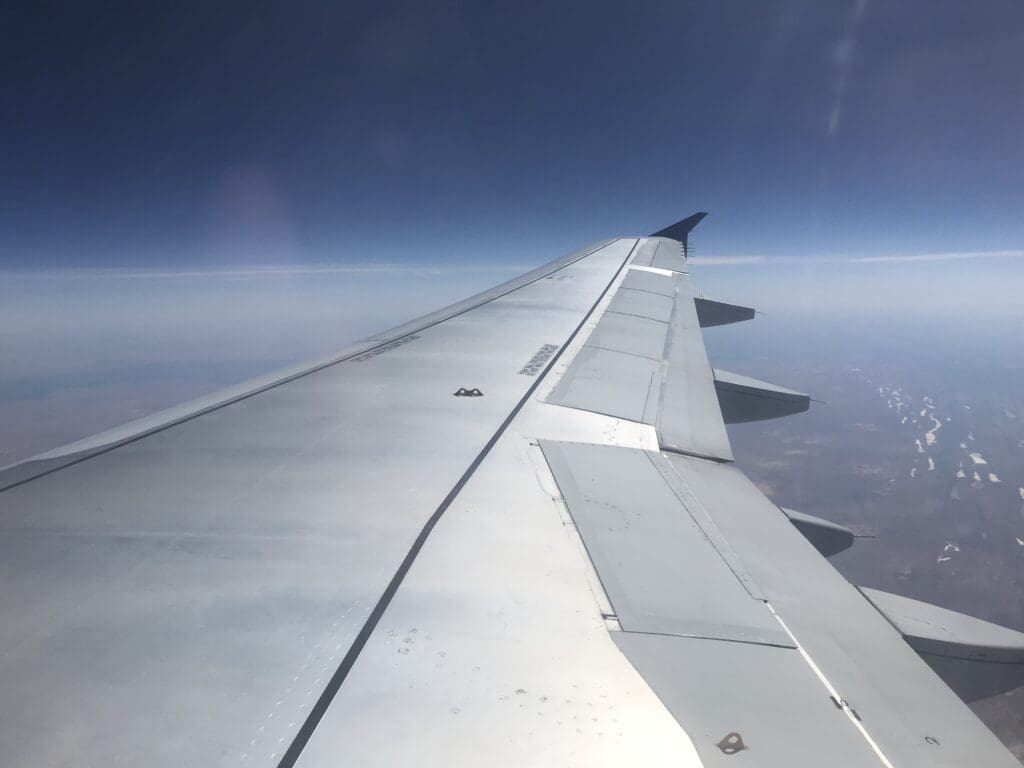
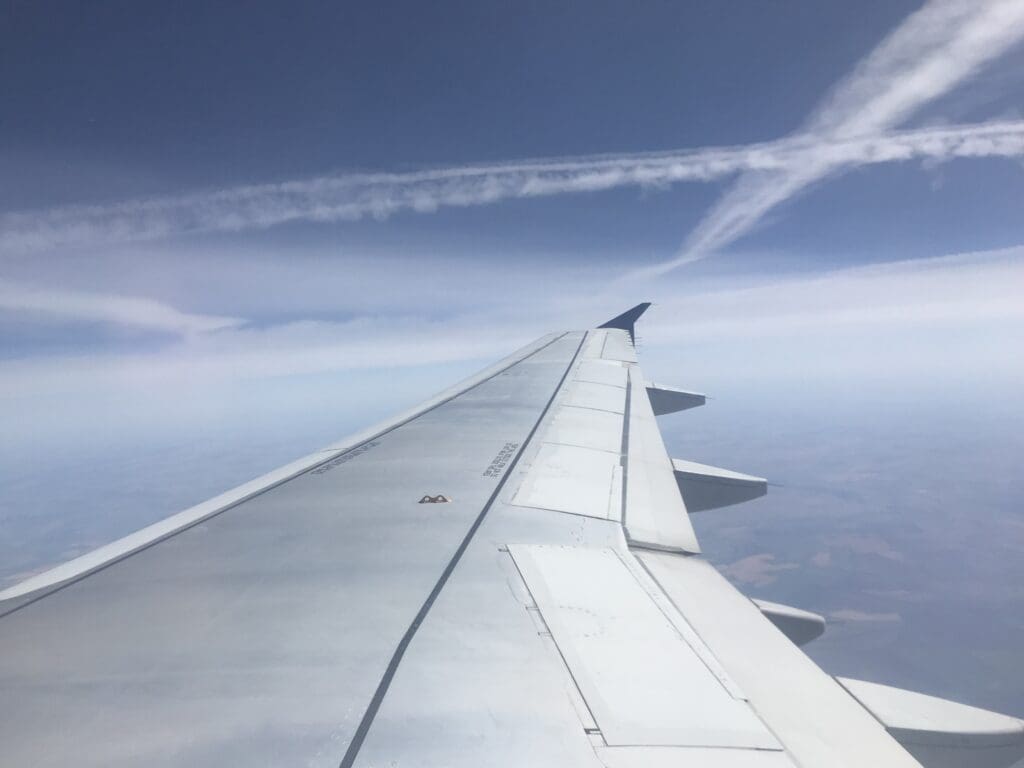
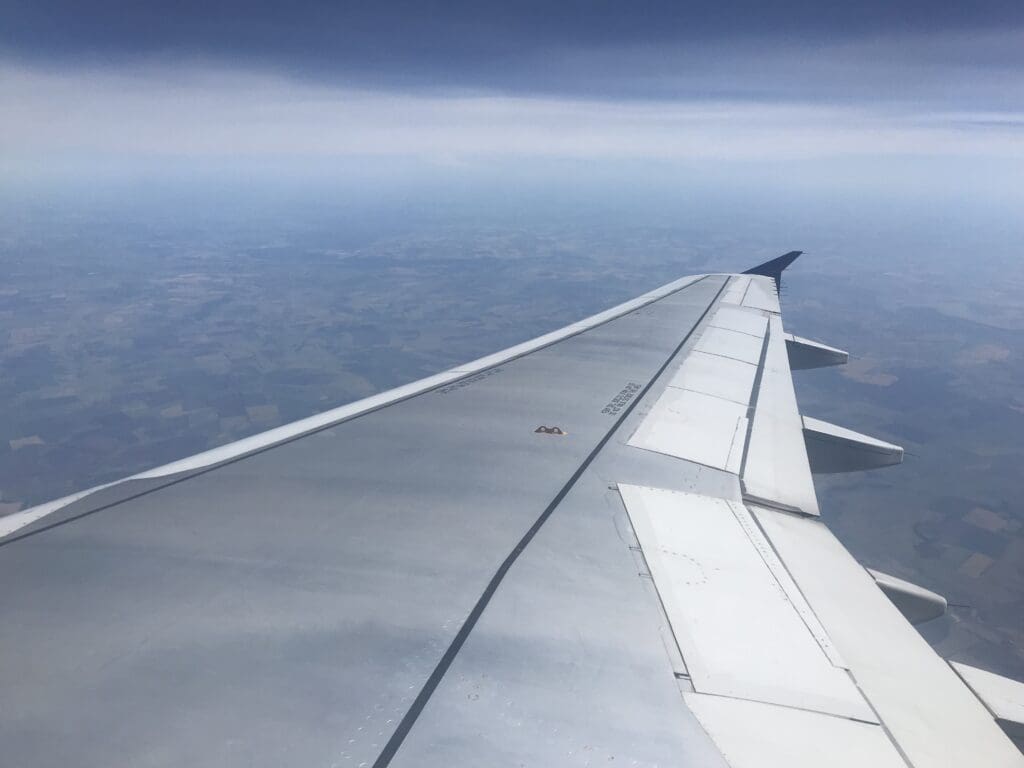
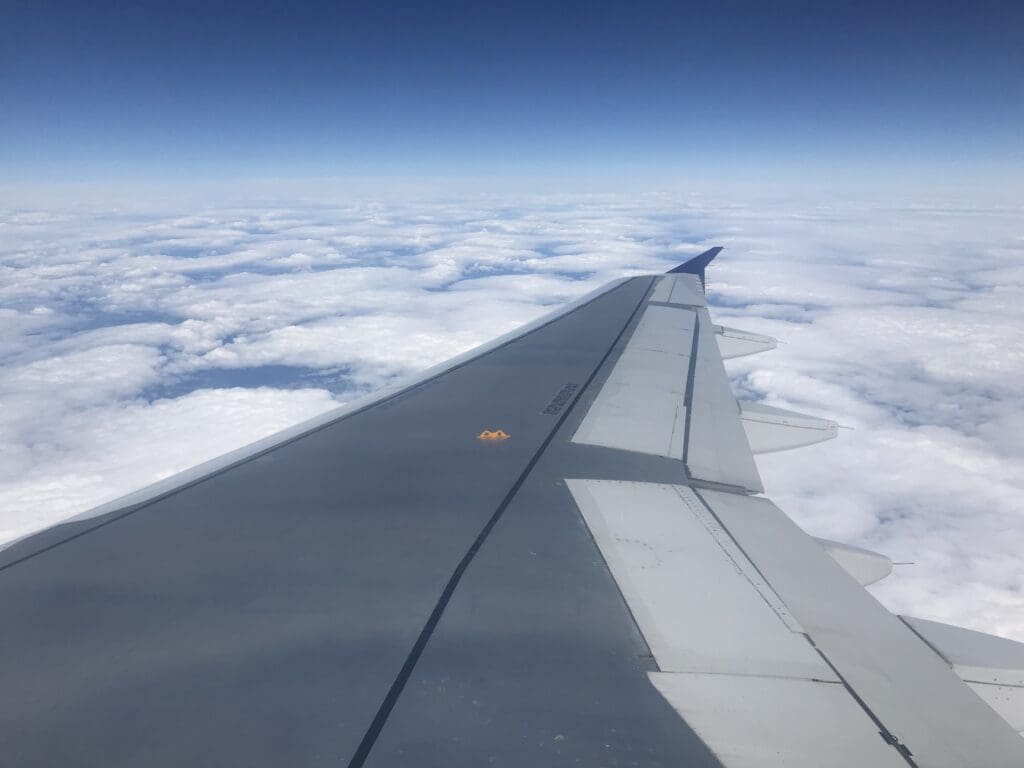
With little to see outside and no interest in the film, I decided to browse the 52nd issue of Azerbaijan Airlines’ inflight magazine. It included articles on the president’s victory in the 2018 election, the history of aviation in Azerbaijan, and travel features on Paris and Nakhchivan. Most articles were published in both English and Russian, though the Paris feature was in Azeri and Russian only. Unlike many inflight magazines, this one was not laden with ads; most were aimed at Azerbaijani readers and promoted bank cards, insurance, real estate, and restaurants.
Around 10:20 Ukrainian time, I headed to one of the two toilets at the rear of the cabin, which, unsurprisingly, was clean and well-stocked with tissues and hand towels, though it lacked soap. By the time I returned to my seat, we had entered Ukrainian airspace and were flying westwards towards Kyiv. At 10:30, the aircraft began its descent, and the crew made a final round collecting rubbish before the aircraft entered a ten-minute break in the clouds, revealing the green fields of Ukraine.
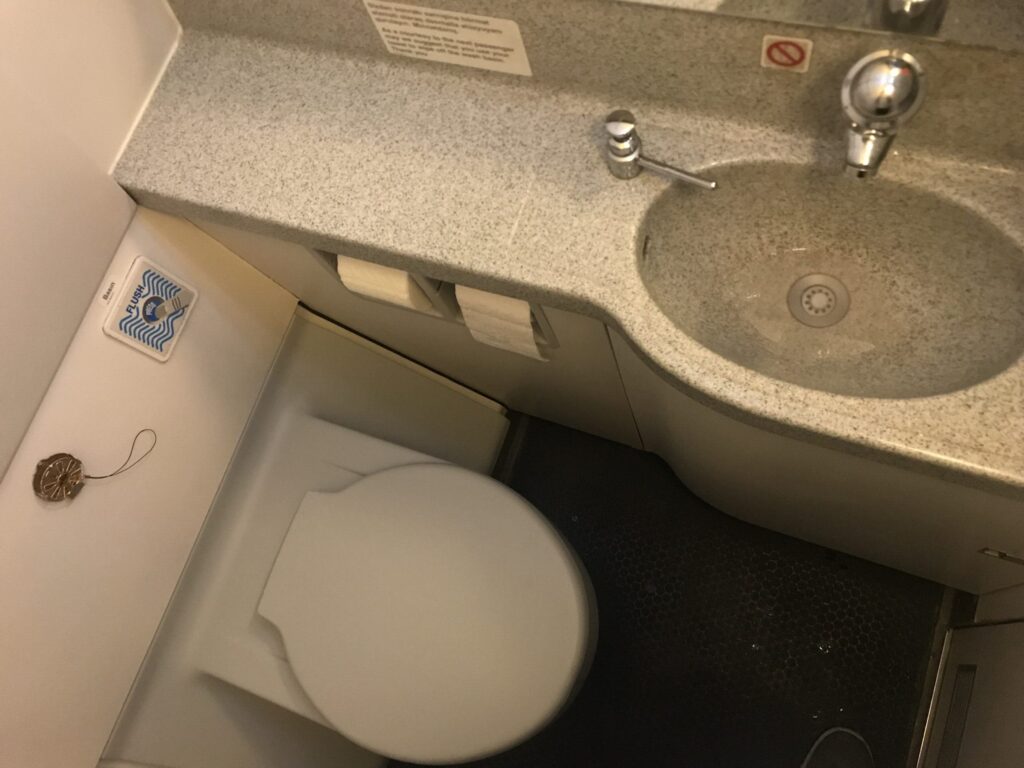
Five minutes before the aircraft reached the clouds, the seatbelt signs illuminated again at 10:50, accompanied by an announcement from the purser about the impending arrival. Emerging from the clouds, the aircraft passed over the city of Brovary, with Kyiv visible in the distance. The aircraft continued its straight-in approach, flying over fields and small clusters of houses before floating above the runway before landing with a small bump.
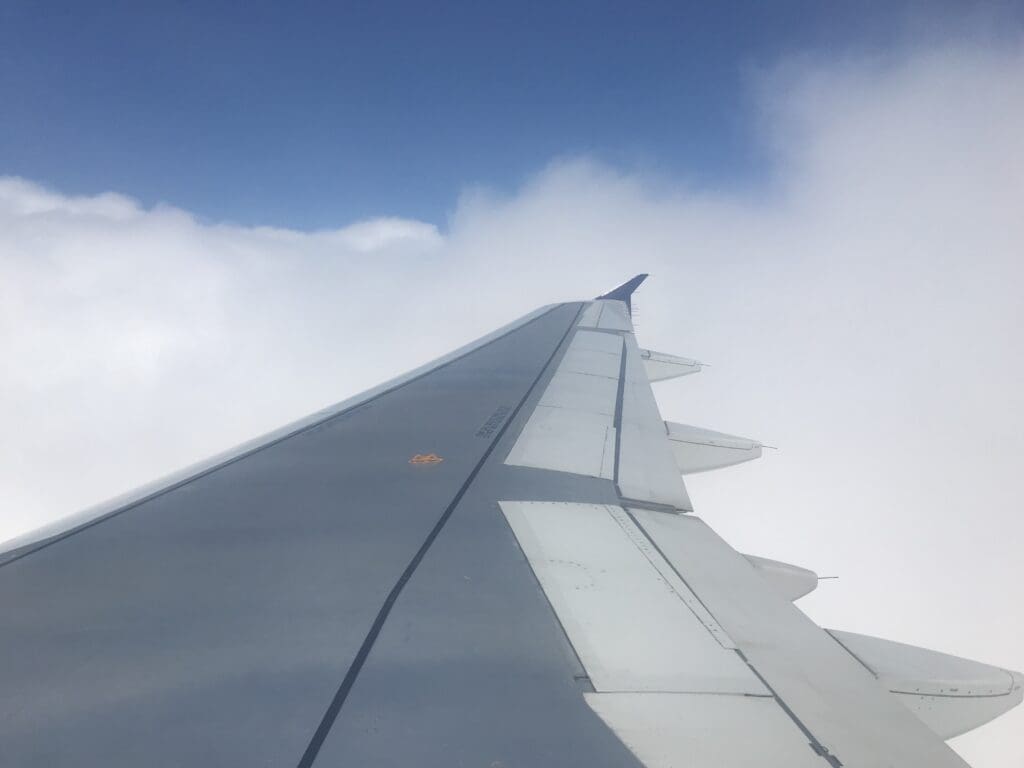
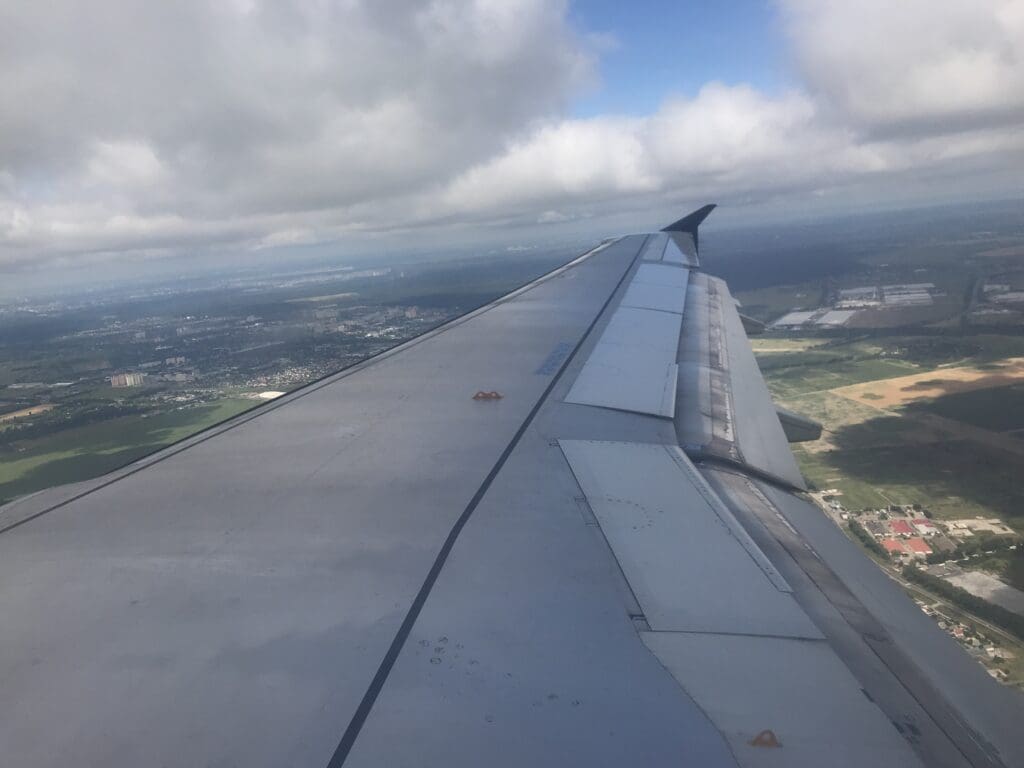
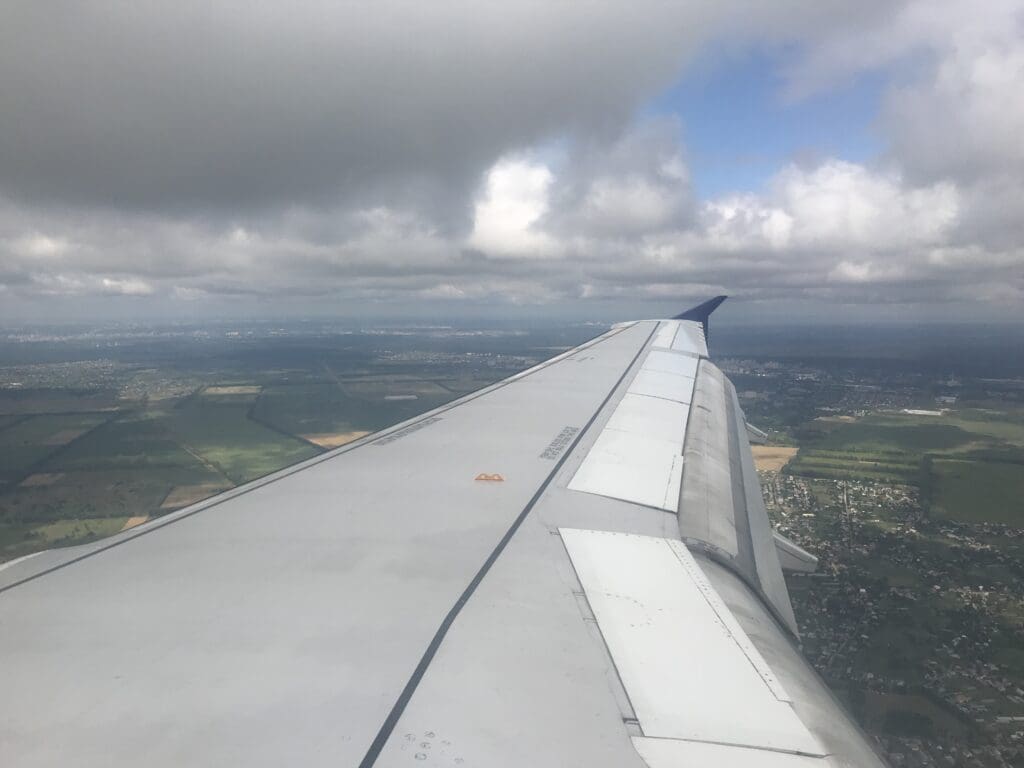
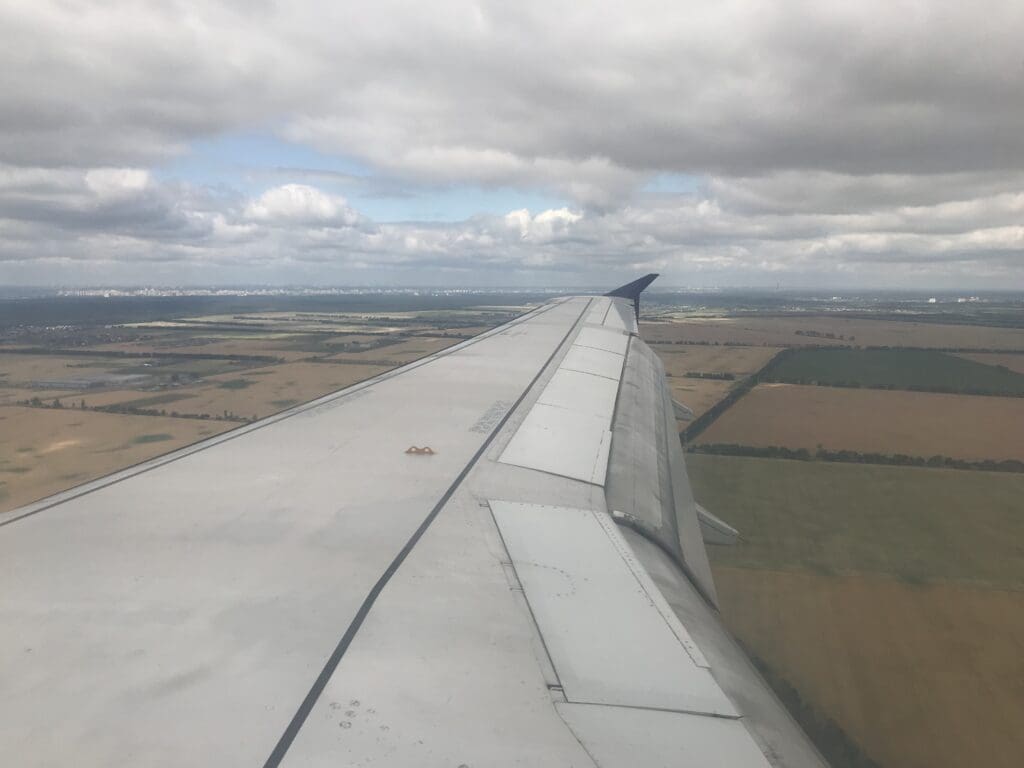
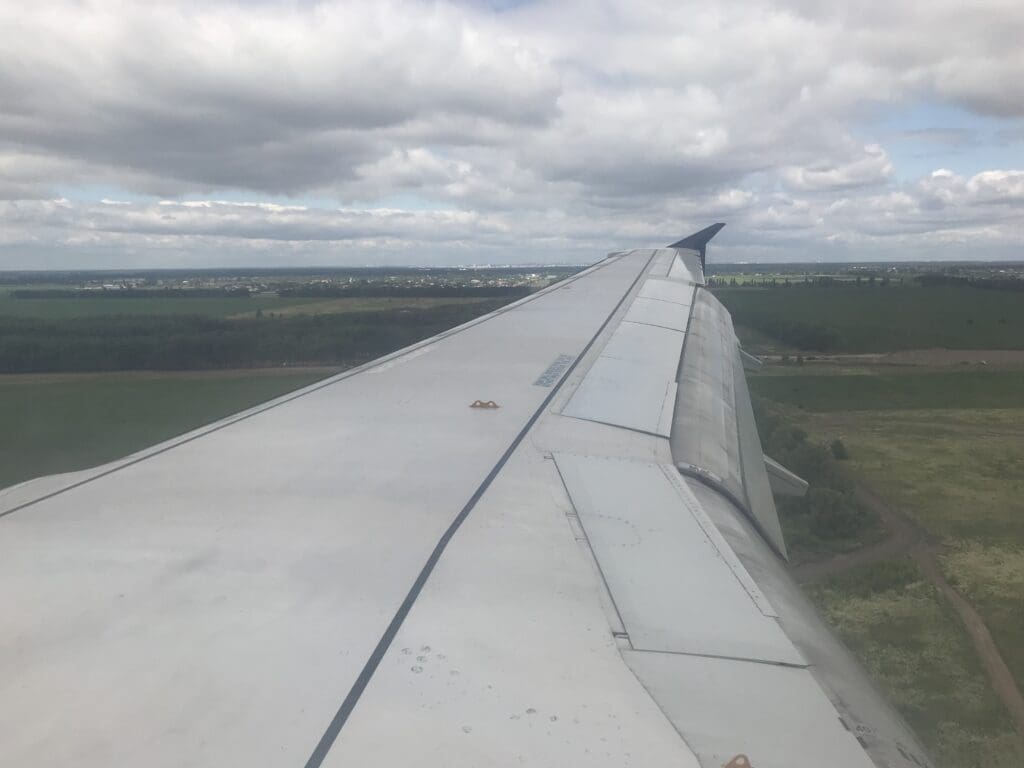
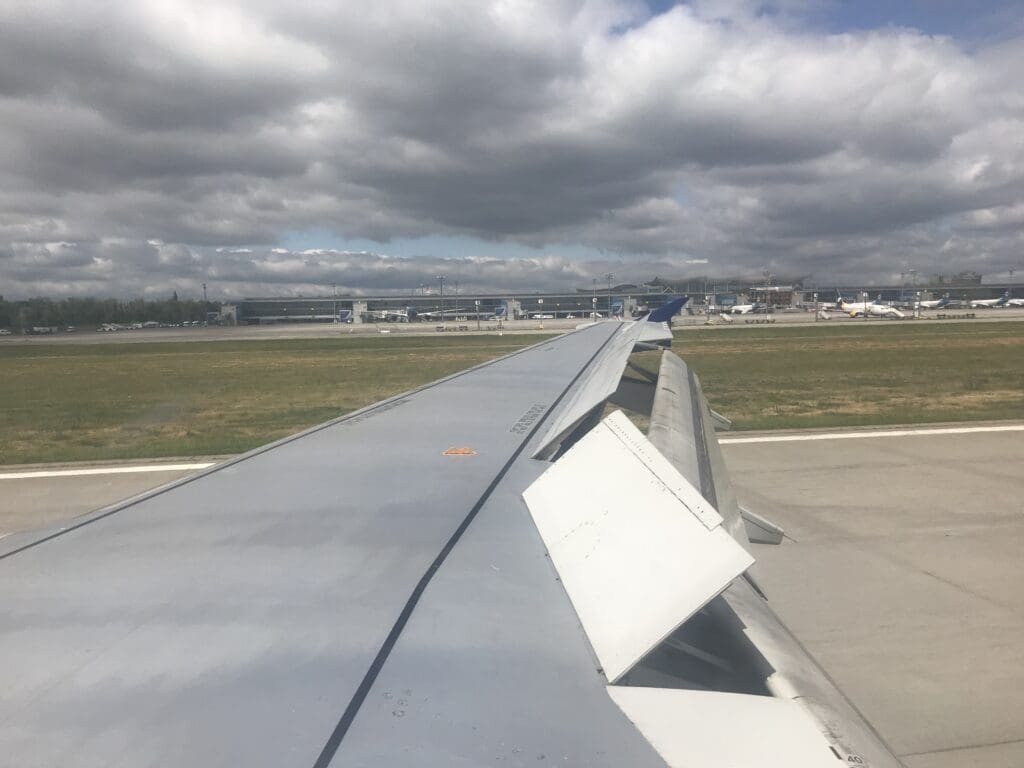
After decelerating quickly, the aircraft turned right off the runway, and the crew welcomed passengers to Kyiv. After a short taxi, the Airbus A319 pulled into Gate 9, becoming the terminal’s only foreign visitor at that time. The engines were shut down, and disembarkation began at 11:12 via a jetbridge sponsored by Azur Air. Following a short wait, I thanked the same two crew members who had welcomed me onto the aircraft in Baku before heading up the jetbridge and into the main terminal. From the aircraft’s arrival gate, only a short walk was required to reach immigration and, seeing as most onboard appeared to hold Ukrainian passports, this was a fairly quick and painless experience.
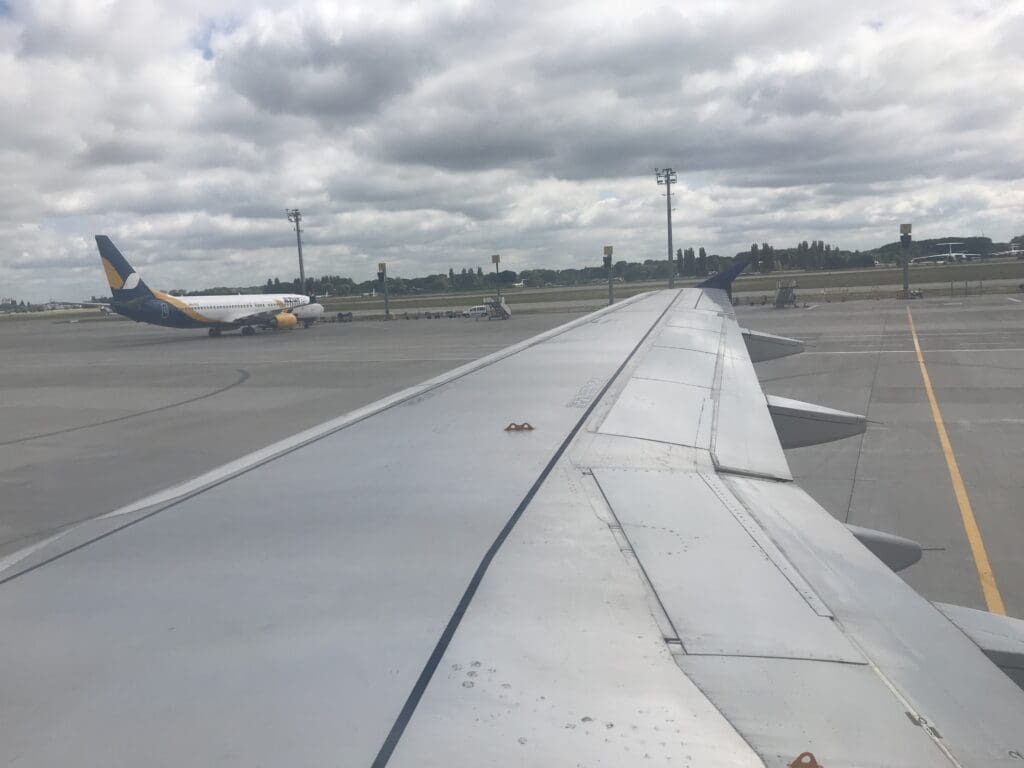
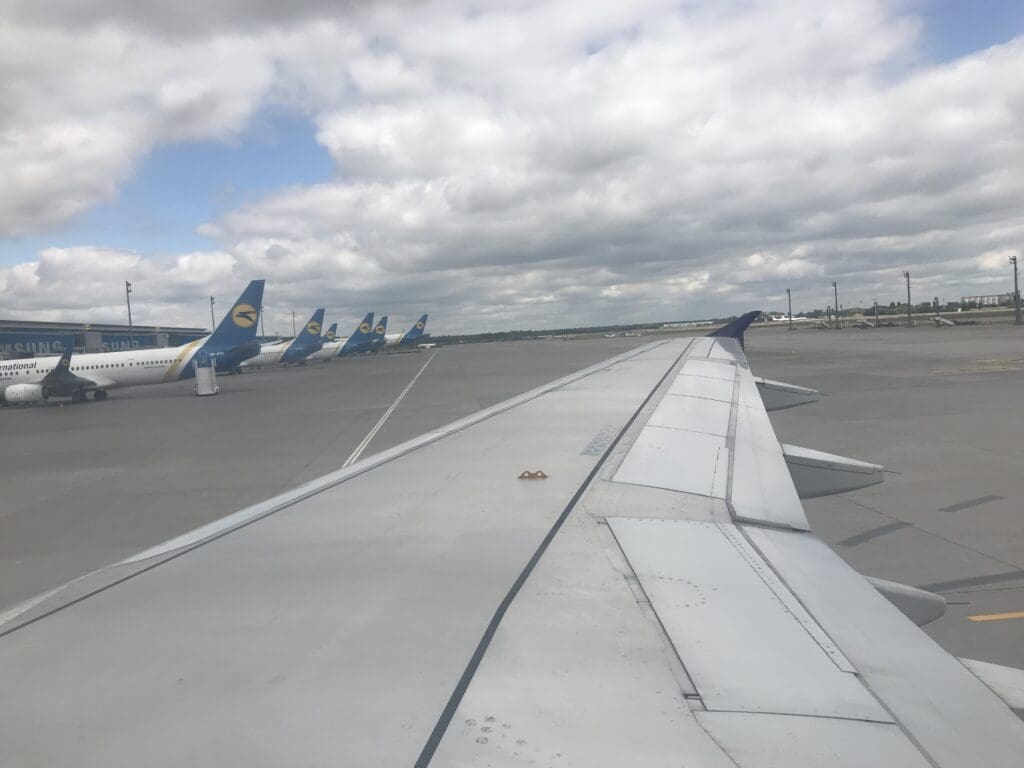
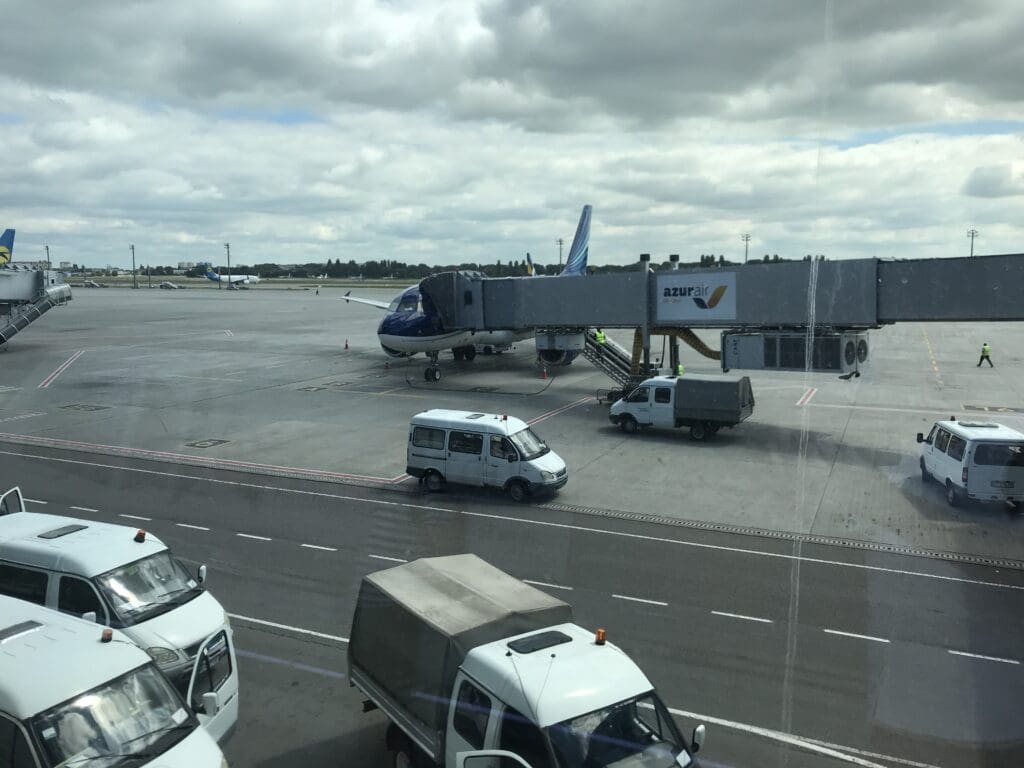
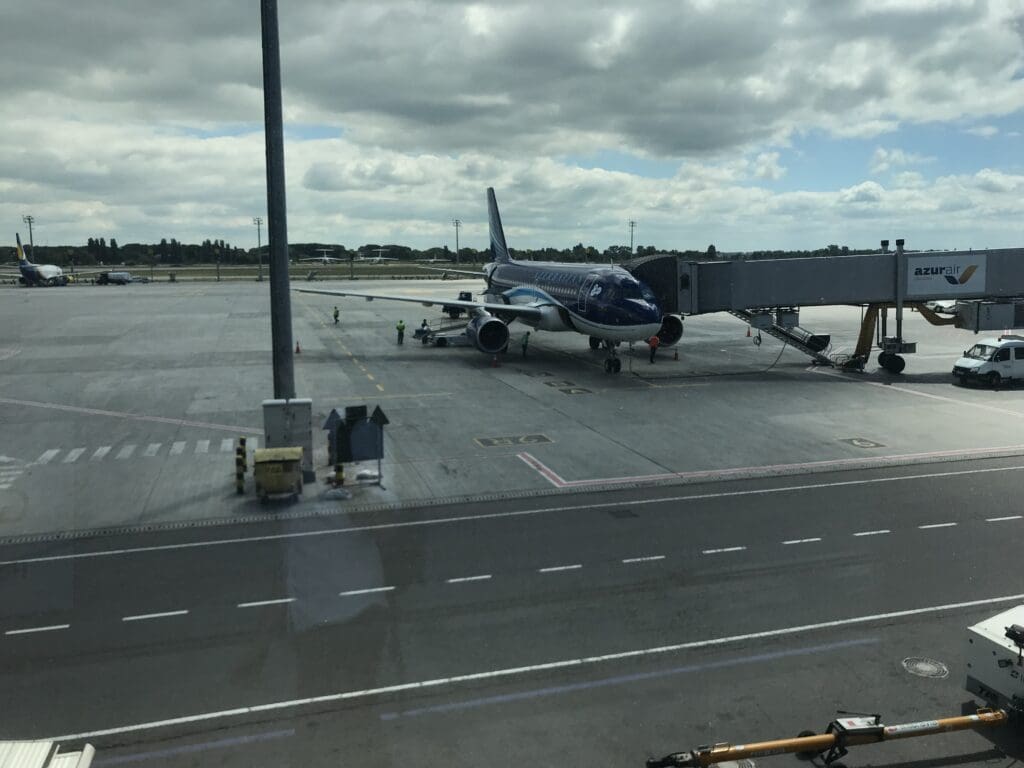
Summary
Whilst I think a number of the crew members could have been a little friendlier, my experience with Azerbaijan Airlines had been pleasantly positive. The Airbus A319 proved itself to be more than comfortable for the three hour journey up to Kyiv whilst I was rather pleased with the breakfast offering onboard. All in all, I was left with no reasons not to fly with the Azerbaijan Airlines again in the future and at some point I would love to sample their Airbus A340 and Boeing 787 economy products.

